|
|
Andrew Winfield Balfour – Deputy Sheriff
Kiowa County Sheriff’s Office, Kansas Killed in Kansas July 2, 1892
Nathaniel Ellsworth “Zip” Wyatt shot up the northern Logan County, O.T. town of Mulhall on Wednesday, June 3, 1891 then fled into Kansas.
On Saturday, July 2, 1892, “Zip” Wyatt stole some riding equipment and a watch from a livery stable in Greensburg, Kansas. A warrant was issued for his arrest. On July 4, 1892, Deputy Balfour, 41, confronted Wyatt at Pryor’s Grove, about ten miles north of Greensburg and attempted to arrest him. “Zip” Wyatt shot Deputy Balfour in the abdomen, the bullet striking his spine and killing him almost instantly. However, Deputy Balfour managed to return fire before he died and hit Wyatt twice in the hand, but the injuries were not serious, and he escaped.
Deputy Balfour was survived by his wife and six children.
Andrew Balfour is buried in Fairview Cemetery, Greensburg, Kiowa County, Kansas.
On August 4, 1895, a posse cornered Wyatt, 32, at Skeleton Creek and engaged in another shootout. Wyatt went down with a gut-shot and a shattered pelvis. He hung on until after midnight on September 7 and died.
OLEM – 5N-2-11 (Belfour) NLEOM – 55W28
For many years it was believed that Andrew W. Balfour was a Logan County, O.T. Deputy Sheriff and had trailed “Zip” Wyatt into Kansas after shooting up Mulhall.
Updated August 8, 2023
|
|
|
|
|
|
David Martellow “Edgar” “Bud” Ballew – Former Deputy Sheriff
Carter County Sheriff’s Office May 5, 1922, Not Line of Duty
David Martellow “Edgar” “Bud” Ballew was born in Fannin County, Texas in 1877 and moved to Oklahoma Territory with his family in 1891 at the age of 14. “Bud” Ballew married Fannie Harper April 17, 1901.
Edgar “Bud” Ballew originally made his living as a cattleman but was commissioned as a Carter County Deputy Sheriff in 1912 by the Sheriff, Buck Garrett. Edgar Ballew would make a name for himself as a lawman and a gunman of the Old West variety, particularly during the last six years of a turbulent decade-long career in law enforcement.
On February 17, 1922, Sheriff Buck Garrett was ousted from the office he had held for eleven years. The deputies Sheriff Garrett had appointed resigned with him, including Edgar “Bud” Ballew. Three days later a shooting incident occurred at the Carter County Court house between three former deputy sheriffs, including “Bud” Ballew, and two current deputies. “Bud” Ballew was wounded in one thigh.
Edgar “Bud” Ballew had mostly recovered from his thigh wound by the first week of May, 1922, when he and his 18-year-old son went to Wichita Falls, Texas, to attend a rodeo. On May 4th Wichita Falls Chief of Police J. W. McCormick was advised that “Bud” Ballew was in town, drinking, armed, and raising hell. The next day, May 5, 1922, the transgressions by “Bud” Ballew became too much when Chief McCormack was called to quell a disturbance caused by “Bud” Ballew at a domino parlor on Ohio Avenue. Chief McCormick accompanied by his Chief of Detectives arrived at the domino parlor about 1:30 p.m. and found “Bud” Ballew setting at the bar. Chief McCormick and his Chief of Detectives approached “Bud” Ballew, each taking a position on either side of Ballew. Chief McCormick told “Bud” Ballew he was under arrest to which Ballew replied with something like “You’re out of luck!” “Bud” Ballew then reached to his side causing Chief McCormick to draw his gun and shot “Bud” Ballew five times, killing him. “Bud” Ballew’s two Colt guns, a .44 and a .45 caliber, were removed from his body as it lay on the floor. Chief McCormick was not prosecuted for killing “Bud” Ballew.
David M. “Bud” Ballew is buried in Lone Grove Cemetery, Long Grove, Carter County, Oklahoma.
OLEM – 7N-1-9
Edgar “Bud” Ballew’s date of death was incorrectly listed on the Oklahoma Peace Officers Memorial when engraved in 1969 as having occurred during the decade of 1928 – 1937.
Updated September 15, 2023
|
|
|
|
|
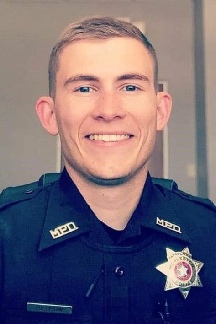
|
Joseph Lee Barlow – Officer
McAlester Police Department March 20, 2023
0Joseph Barlow was born on November 4, 1996. Joseph Barlow attended McAlester High School graduating from there in 2015.
While still in high school Joseph Barlow joined the U.S. Army Reserves on November 5, 2013, and served until November 4, 2021. Joseph played the bugle at numerous military funerals while in the reserves.
In 2018 Joseph Barlow went to work as a Correctional Officer at Jackie Branon Correctional Facility where he served for three years. While at the Jackie Branon facility Joseph served on their CERT Team and was a member of their Honor Guard unit.
On August 2, 2021, Joseph Barlow became a McAlester Police officer.
The morning of Thursday, March 16, 2023, McAlester Police Captain Richard Parker failed to show up for his shift. Officers found that Captain Parker had passed away in his sleep during the night. Captain Parker’s body was taken to the Medical Examiner’s office in Tulsa for an autopsy. Following the autopsy Captain Parker’s body was released for burial the afternoon of Friday, March 17th. A detail of McAlester officers, including Officer Joseph Barlow, 25, were sent to Tulsa to escort the body of Captain Parker from the Medical Examiner’s office in Tulsa to a funeral home in Wetumka. About 6:30 p.m. the procession of escort police cars and hearse were traveling on State Highway 75, just north of 151st Street, South in Glenpool when the driver of a black pickup truck going the opposite direction on the highway lost control, crossed the center medium, and struck Officer Joseph Barlow’s police car head-on. Officer Barlow was transported to St. John Medical Center in Tulsa in critical condition and died there from his injuries the morning of Monday, March 20, 2023.
Officer Joseph Barlow was survived by his wife Chaise Iskey, and their one-year-old son Hudson.
Following a memorial service at the Southeast Expo Center in McAlester on Wednesday, March 29, 2023, the earthly remains of Officer Joseph Barlow were escorted back to the funeral home where they were cremated.
The escort procession for Captain Parker to the funeral home in Wetumka was continued after the accident by officers of the Creek Nation Tribal Police.
The driver of the black pickup truck, Martin Rivas Rodriguez, 39, was charged with felony first-degree manslaughter-automobile, causing a fatality accident without a valid driver’s license, plus misdemeanor counts of reckless driving and no valid driver’s license and was being held for U.S. Immigration and Customs Enforcement.
OLEM – NLEOM –
Updated August 10, 2023
|
|
|
|
|
|
Joe Barnett - Officer
Creek Nation Lighthorse, Indian Territory July 30, 1882
Between 1878 and 1883, a civil war erupted between factions of the Creek Nation. One faction, the Sands Men were a gang of about four hundred led by the outlaw Dick Glass. The other faction was the Creek National Constitutional Party.
In late July, a party of about seventy-five Creek National Constitutional Party Lighthorse visited the neighborhood of the Sands Men, in the northwestern part of the Creek Nation, and arrested a notorious character. They placed the notorious character in the charge of Captain Sam Scott and three other Lighthorse including Joe Barnett, a black Creek Lighthorse.
On Sunday morning, July 30, 1882, about daylight, a company of Sands Men attacked the four Creek Lighthorse, rescued their prisoner and murdered Captain Sam Scott in cold blood. Captain Scott was held by the hands with his arms stretched out by men on either side of him while others filled his body with bullets. His body was pulled and torn and shot until it was nearly unrecognizable.
Officer Joe Barnett, in trying to aid his Lighthorse captain was also fatally shot.
In April of 1883, several men were captured and taken to their respective districts to be turned over to the civil authorities for trial. One of the men, He-ne-ha Chupko, tried to escape on horseback but the guards fired on him, killing him instantly. He was one of the leaders in the killing of Captain Sam Scott and his officer, Joe Barnett.
The burial site of Captain Sam Scott or Officer Joe Barnett is unknown.
OLEM – 2N-3-2 NLEOM – 55E18
Updated August 10, 2023
|
|
|
|
|
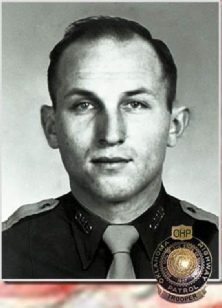
|
John Richard Barter - State Trooper
Oklahoma Highway Patrol January 23, 1959
About 4:30 p.m. on Friday, January 23, 1959 Trooper John Barter, 31, turned on to a county road off U. S. Highway 62 about three miles west of Altus to investigate several shots he had heard. Trooper Barter drove upon a man and a woman setting in a car. When Trooper Barter went to arrest the man, Ray Allen Young, 29, for being a parolee in possession of a gun, Ray Young shot and killed Trooper Barter with a .32 caliber pistol. Ray Young and the woman, a prostitute named Bernice Scott, were later apprehended and both were convicted of Trooper Barter’s murder.
Ray Young died in Oklahoma’s electric chair on December 15, 1960 becoming the only man executed for killing an Oklahoma Highway Patrol Trooper. Bernice Scott was sentenced to life in prison and was paroled in 1975.
Trooper John Barter was survived by his wife and three sons and is buried in Frederick Memorial Cemetery, Frederick, Tillman County, Oklahoma.
OLEM – 7N-5-14 NLEOM – 51W14
Updated August 10, 2023
|
|
|
|
|
|
Edward "Ed" Baum - City Marshal
City of Checotah March 27, 1909
City Marshal Edward Baum, 38, was one of six officers who had gone to the house of Chitto “Crazy Snake” Harjo, leader of a militant group of Creek Indians, to arrest him for larceny on Saturday, March 27, 1909. Near dusk the officers approached the house and shots were fired as several Indians ran from the house. Marshal Edward Baum was the first officer to be shot and killed. McIntosh County Deputy Sheriff Herman Odom tried to get to Baum but was himself shot and killed.
A wife and three children survived City Marshal Edward Baum.
Edward Baum is buried in Oak Cemetery, Fort Smith, Sebastian County, Arkansas.
OLEM – 8S-1-19 NLEOM – 5W24
Updated August 10, 2023
|
|
|
|
|
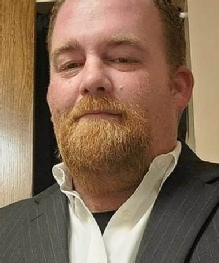
|
Justin Conrad Baxter – Deputy Sheriff
Canadian County Sheriff’s Office September 8, 2022
Justin Baxter was born September 12, 1989, in Denver, Colorado to Nicholas Conrad and Delynda Rai “Lindy” (Stewart) Baxter.
Deputy Sheriff Justin Baxter, 32, had transported several high-risk felony prisoners on Wednesday, September 7, 2022. That evening at home Deputy Baxter complained of shortness of breath and chest pains. The early hours of Thursday, September 8, 2022, Deputy Sheriff Justin Baxter was transported to Integris Canadian Valley Hospital where they were unable to revive him, and he was pronounced dead at 2:34 a.m.
Deputy Sheriff Justin Baxter’s earthly remains were cremated.
Deputy Sheriff Justin Baxter was survived by his wife Tiffany and daughters Kayla, 7, and Kinley, 2.
OLEM – 4N-3-21 NLEOM –
Updated September 3, 2023
|
|
|
|
|
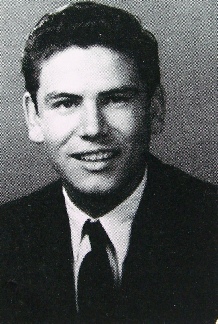
|
Jerry Mack Beall - Deputy Sheriff
Payne Country Sheriff's Office July 30, 1968
On Tuesday, July 30, 1968, Deputy Sheriff Jerry Beall, 26, along with the Chief of Police of Cushing, Oswell “Joe” Rowden, 60, was transporting two unhand cuffed prisoners from Cushing to the Payne County Jail in Stillwater. Shortly after 3:00 p.m., approximately six miles east of Stillwater on Highway 51, one of the prisoners, Marvin R. Gibson, Jr., 19, attacked Deputy Sheriff Jerry Beall, who was driving, wrenching the steering wheel sideways. The car crossed over the centerline hitting an oncoming car head-on. Both officers were killed instatnly. Deputy Sheriff Jerry Beall was pinned by the steering wheel and Chief “Joe” Rowden was thrown through the windshield. Both prisoners received minor injuries but did not escape. Driver of the other car survived his injuries.
Deputy Sheriff Jerry Beall had served as a Payne County Deputy Sheriff for five years and had served with the Cushing Police Department before becoming a deputy sheriff.
Deputy Sheriff Jerry Beall was survived by his wife Ida and two young sons and is buried in Fairlawn Cemetery, Cushing, Payne County, Oklahoma.
Marvin Gibson was convicted of the murders of the two officers and sentenced to life in prison but was patrolled in the 1970’s.
In May 2009 State Highway 51 in Payne County between State Highway 108 and state highway 177 was named the “Sheriff Jerry Beall and Police Chief Joe Rowden Memorial Highway.”
OLEM – 7N-5-19 NLEOM – 38W1
Updated August 10, 2023
|
|
|
|
|
|
John M. Beard - Deputy U.S. Marshal
U. S. Marshal Service December 9, 1894
John M. Beard was born on November 3, 1855, in the CooWeeScooWee District of the Cherokee Nation in the Indian Territory. On July 10, 1873, John Beard married Beulah Ann “Lovely” Bushyhead and they had three children, Elizabeth “Lizzy”, Henry, and Beulah M.
On July 13, 1893, United States Marshal George Crump of the Western District of Arkansas appointed John Beard as a Deputy U.S. Marshal. John Beard was also the town marshal of Claremore, in the Cherokee Nation in the Indian Territory.
Deputy John Beard, 39, and Deputy U. S. Marshal Hultz, who was unarmed, rode to the ranch of Bob Hendricks five miles southwest of Claremore on the morning of Sunday, December 9, 1894, for the purpose of returning a saddle that Deputy Hultz had borrowed. When they arrived the deputy marshals were met by James Price, who was pointing a Winchester rifle at them. The deputy marshals believed that James Price was wanted on several charges by the U. S. and Cherokee courts. Deputy John Beard drew his pistol and fired at Price but missed him. James Price then shot Deputy Marshal John Beard in the head killing him. Price then allowed the unarmed Deputy Marshal Hultz to ride away. Price then took Deputy Marshal John Beard’s gun and rode off.
Deputy John Beard was survived by his wife and three children and is buried at Woodlawn Cemetery, Claremore, Rogers County, Oklahoma.
James Price was later arrested and in February 1895, a federal commissioner held a hearing on the killing of Deputy Marshal John Beard. The commissioner ruled that since the deputies did not have warrants for Price’s arrest on their persons, and since Deputy Marshal John Beard fired first, that James Price should be released on the charge of murder however Price was held on other charges that had been filed against him.
OLEM – 9N-1-13 NLEOM – 27W8
Updated December 6, 2023
|
|
|
|
|
|
Seth Beardsley - Deputy U S Marshal
U. S. Marshal Service October 1, 1873
Deputy Marshal Seth Beardsley was working out of Fort Smith, Arkansas under U. S. Marshal John Sarber.
On Wednesday, October 1, 1873, Deputy Marshal Seth Beardsley and his posse, M. H. Adams were taking twenty-six Osage Indians who were charged with murder back to Fort Smith for trial. The day grew late, so the two lawmen set up camp thirty miles from Fort Gibson near Kansas, Indian Territory, in the Cherokee Country.
The prisoners were secured, but sometime during the night the prisoners were able to secure a gun, shoot both of the lawmen to death and escape. Even though the U. S. Army helped other deputy marshals in the search no record can be found of the identity of the escaped prisoners or if they were ever recaptured.
The burial site of Deputy U.S. Marshal Seth Beardsley is unknown.
OLEM – 9N-2-4 NLEOM –
Updated August 10, 2023
|
|
|
|
|
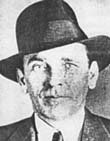
|
John Harold Beasley - Patrolman
Oklahoma City Police Department May 22, 1933
Officer John Beasley, 45, was riding in the back seat of a police car with a suicidal mental patient named James Ferguson who the officers had just taken a gun off and arrested in an alley at N. W. 4 and Hudson, on the morning of Thursday, May 18, 1933. Soon after placing Ferguson in the police car, it was discovered that he had a box containing twenty-four sticks of dynamite strapped to his body. The officers were driving to a less populated area when Officer Beasley began struggling with James Ferguson in the 100 block of N. W. First Street (now Park Avenue). Officer John Beasley was shot twice, perhaps with his own weapon, before other officers fatally shot James Ferguson thirteen times. The box of dynamite was then removed from Ferguson and later harmlessly detonated.
Officer John Beasley died from his wounds four days later Monday, May 22, 1933, and is buried in Memorial Park Cemetery, Oklahoma City, Oklahoma County, Oklahoma.
OLEM – 7N-1-13 NLEOM – 63W15
Updated August 10, 2023
|
|
|
|
|
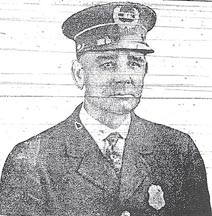
|
William Thompson Beasley - Deputy Sheriff
Tulsa County Sheriff's Office September 11, 1919
Deputy Sheriff William Beasley, 52, was one of several deputies who concealed themselves around a bank in Red Fork, a small town four miles west of Tulsa, after they were tipped off that the bank would be robbed on Thursday, September 11, 1919.
Deputy Sheriff William Beasley was concealed in a barn behind the bank. At 1 p. m. the bank was robbed and when the robbers exited and started down the alley next to the bank a gun battle broke out. One robber, H. F. “Frank” Tyson, 23, was killed and another, William Rooker, 22, was wounded. The third robber, John Scott, the informant, was uninjured as he stopped just outside the bank’s door. Deputy Sheriff William Beasley was later found dead in the barn apparently hit by a stray bullet from one of his colleagues.
Deputy Sheriff William Beasley was survived by his five adult children and is buried in Rose Hill Memorial Park, Tulsa, Tulsa County, Oklahoma.
OLEM – 3S-2-13 NLEOM – 51W18
Updated August 10, 2023
|
|
|
|
|
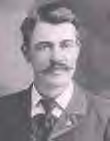
|
Addison J. Beck - Deputy U.S. Marshal
U.S. Marshal September 27, 1883
By 1883 Addison Beck had been a Deputy U.S. Marshal working out of the Fort Smith, Arkansas court for eight years and promised his wife he would find a safer occupation after one more trip to the Indian Territory. During that last trip Deputy Addison Beck and his posseman Lewis Merritt were looking for John Bart (or Bark) for whiskey violations.
About 11 a. m. on Thursday, September 27, 1883, they located John Bart working in a corn field with Johnson Jacks near Big Vienne, east of Webbers Falls and about 40 miles from Fort Smith. As the officers approached the men a gun battle broke out and Deputy Addison Beck was shot in the head and killed instantly. Posseman Lewis Merritt was wounded in the chest and head and was still alive when a wounded Johnson Jacks approached Deputy Merritt and shot him several more times before beating his head in with a gun.
Deputy Adison Beck was survived by his wife and was proceeded in death by their four children.
Addison Beck is buried next to his Posseman Lewis Merritt in Oak Cemetery, Fort Smith, Sebastian County, Arkansas.
OLEM – 5N-1-14 NLEOM – 12E16
Updated August 10, 2023
|
|
|
|
|
|
Jesse “Black Sut” Beck - Posse/Deputy U.S. Marshal
U.S. Marshal Service April 15, 1872
Jesse “Black Sut” Beck, 25, was one of eleven people killed and as many as nineteen wounded on Monday, April 15, 1872, at the Whitmire Schoolhouse east of Tahlequah, near the modern town of Christie in Adair County in the Going Snake District of the Cherokee Nation.
Zeke Proctor was being tried by the Cherokee Nation at the schoolhouse for accidentally killing a widow named Polly Beck Hildebrand. The relatives of Polly convinced the federal court at Fort Smith to intervene in the case. The U.S. Commissioner issued an arrest warrant for Zeke Proctor on a charge of “assault with intent to kill” to Deputy U.S. Marshals Jacob G. Owens and Joseph S. Peavey. The Deputy Marshals led a deputized posse including friends and relatives of Polly Beck Hildebrand to the schoolhouse. As the federal posse entered the schoolhouse a massive gun battle erupted. Posse members Jesse “Black Sut” Beck, Samuel Beck, William Hicks, George Selvidge, James Ward, and Riley Woods were shot and killed that day. Deputy U.S. Marshal Jacob Owens and Posse William Beck were also wounded and died the next day, April 16th from their gunshot wounds.
Jesse “Black Suit” Beck was survived by his wife Julia and 8-month-old son John and is buried in the Beck Cemetery, Colcord, Delaware County, Oklahoma.
OLEM – 9N-1-6 NLEOM – 32W8
Updated August 10, 2023
|
|
|
|
|

|
Brian David Beck - Undersheriff
Washita County Sheriff’s Office January 23, 2014
At approximately 9:30 a.m. the morning of Thursday, January 23, 2014, Undersheriff Brian Beck, 40, went to the home of Quentin Lee Johnson, in Sentinel, with a felony arrest warrant for Johnson. When Johnson, 27, observed Undersheriff Beck approaching the house Johnson jumped in his 2011 Ford pickup truck and sped off. Undersheriff Beck began pursuing Johnson going out of Sentinel. Just after 10 a.m. at the intersection of County Road E1210 and County Road N2160 (Rambo Road) south of Dill City Undersheriff Brian Beck’s south bound county SUV collided with the east bound patrol car of Burns Flat Police Officer Kristian Willhight who was in route to assist Undersheriff Beck in the pursuit. Both officers died at the scene of the accident.
About the same time three miles east of the officers’ crash Quentin Johnson lost control of his pickup and crashed into a ravine on County Road E1210 near County Road N 2190 killing him.
Undersheriff Brian Beck was hired as a Canute Police Officer in 1998 as well as a Reserve Deputy Sheriff for Washita County before becoming a full time Deputy Sheriff in 2001. In 2013 Beck was named Undersheriff of Washita County.
Brian Beck was survived by his wife of twelve years, Shannon, and their daughters Melinda and Kamie.
Brian Beck’s earthly remains were cremated.
OLEM – 4N-1-7 NLEOM – 31E29
Updated August 10, 2023
|
|
|
|
|
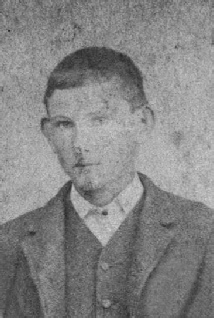
|
George E. Beck - Deputy Sheriff
Caddo County Sheriff's Office, O.T. January 15, 1902
On the morning of Wednesday, January 15, 1902, Caddo County Sheriff Frank Smith, 41, and his deputies George Beck, 30, and Bill Briggs went to a cabin three miles east of Fort Cobb to arrest members of the Casey Gang who robbed a man the night before in Anadarko. The gang, which was made up of several notorious outlaws, consisted of Bert Casey, Sam Casey, Bill Wilson, and a man named Swofford, all were wanted for horse stealing and robbery.
The officers surrounded the cabin and called for the wanted men to come out. The officers were greeted by gun fire. The first volley wounded Sheriff Frank Smith and Deputy Sheriff George Beck. Deputy Sheriff Beck was wounded four times, with bullets in his chest and left arm which was shattered, killing him instantly. Sheriff Frank Smith was shot through the chest and died within a few minutes. Deputy Sheriff Bill Briggs was able to escape being wounded and went for help.
The lawmen’s killers approached their victims robbing them of their possessions. Bert Casey is reported to have put his foot on the chest of Sheriff Smith as Smith took his final breath. A posse was soon formed and trailed the murderers in the snow where they eventually overcame the outlaws near Wewoka, Indian Territory. One of the outlaws, Swofford, was killed in the ensuing shootout and two others, Sam Casey, and Bill Wilson were captured. Bert Casey escaped.
Bert Casey and was killed by a fellow outlaw named Fred Hudson on November 3, 1902, near Cleo Springs for the reward offered for Bert Casey, dead or alive.
The burial site of George Beck is unknown as his body was lost or destroyed.
OLEM – 5N-4-7 NLEOM – 64E23
Updated August 10, 2023
|
|
|
|
|
|
Samuel Beck - Posse, Deputy U.S. Marshal
U.S. Marshal Service April 15, 1872
Samuel Beck, 38, was one of eleven people killed and as many as nineteen wounded on Monday, April 15, 1872, at the Whitmire Schoolhouse east of Tahlequah, near the modern town of Christie in Adair County in the Going Snake District of the Cherokee Nation.
Zeke Proctor was being tried by the Cherokee Nation at the schoolhouse for accidentally killing a widow named Polly Beck Hildebrand. The relatives of Polly convinced the federal court at Fort Smith to intervene in the case. The U.S. Commissioner issued an arrest warrant for Zeke Proctor on a charge of “assault with intent to kill” to Deputy U.S. Marshals Jacob G. Owens and Joseph S. Peavey. The Deputy Marshals led a deputized posse including friends and relatives of Polly Beck Hildebrand to the schoolhouse. As the federal posse entered the schoolhouse a massive gun battle erupted. Posse members Jesse “Black Sut” Beck, Samuel Beck, William Hicks, George Selvidge, James Ward, and Riley Woods were shot and killed that day. Deputy U.S. Marshal Jacob Owens and Posse William Beck were also wounded and died the next day, April 16th from their gunshot wounds.
Posse Samuel Beck is buried in Beck Cemetery, Colcord, Delaware County, Oklahoma.
OLEM – 10S-3-10 NLEOM – 42W13
Updated August 10, 2023
|
|
|
|
|
|
William "Bill" Beck - Posse, Deputy U.S. Marshal
U.S. Marshal Service April 16, 1872
William Beck was one of eleven people killed and as many as nineteen wounded on Monday, April 15, 1872, at the Whitmire Schoolhouse east of Tahlequah, near the modern town of Christie in Adair County in the Going Snake District of the Cherokee Nation.
Zeke Proctor was being tried by the Cherokee Nation at the schoolhouse for accidentally killing a widow named Polly Beck Hildebrand. The relatives of Polly convinced the federal court at Fort Smith to intervene in the case. The U.S. Commissioner issued an arrest warrant for Zeke Proctor on a charge of “assault with intent to kill” to Deputy U.S. Marshals Jacob G. Owens and Joseph S. Peavey. The Deputy Marshals led a deputized posse including friends and relatives of Polly Beck Hildebrand to the schoolhouse. As the federal posse entered the schoolhouse a massive gun battle erupted. Posse members Jesse “Black Sut” Beck, Samuel Beck, William Hicks, George Selvidge, James Ward, and Riley Woods were shot and killed that day. Deputy U.S. Marshal Jacob Owens and Posse William Beck were also wounded and died the next day, April 16th from their gunshot wounds.
The burial site of William Beck is unknown.
OLEM – 10S-3-7 NLEOM – 2E5
Updated August 10, 2023
|
|
|
|
|
|
Richard D. "Dick". Bell - Night Officer
Haileyville Police Department October 6, 1909
The early morning of Wednesday, October 6, 1909, about 3 a.m. Night Officers Richard “Dick” Bell and Maybury were advised of a disturbance at a house. As the two officers entered the house Officer Richard Bell was shot in the face with a .45 caliber revolver and killed.
Two men and a woman named “Big Myrt” Smith were arrested and charged with Officer Richard Bell’s murder. “Big Myrt” was the only one convicted of Officer Richard Bell’s death and received an eight-year prison sentence for manslaughter.
Officer Richard Bell was survived by his wife Ida and two sons, Thomas, 20, and Herman, 12 and is buried in Elmwood Cemetery, Hartshorne, Pittsburg County, Oklahoma.
OLEM – 10N-2-13 NLEOM – 63W26
Updated August 10, 2023
|
|
|
|
|
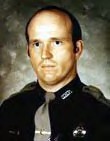
|
Travis Leon Bench -State Trooper
Oklahoma Highway Patrol October 5, 1983
Trooper ‘Leon’ Bench stopped Charles Enoch Brown for a traffic violation about 10:30 a.m. the morning of Monday, October 5, 1983, on Highway 97 one mile north of the Sapulpa exit of the Turner Turnpike. When Trooper Leon Bench attempted to arrest Charles Brown for driving with a suspended driver’s license Brown broke loose, ran to his car, retrieved a .44 magnum pistol, and shot Trooper Leon Bench in the head. Charles Brown escaped, and Trooper Bench died shortly after noon in a Tulsa hospital.
Trooper Travis Leon Bench was survived by his wife MaryAnn and their four-month-old daughter Chelsea and is buried in Vernon Cemetery, Coweta, Wagoner County, Oklahoma.
Charles Enoch Brown was soon captured, tried for murder, and sentenced to life in prison.
OLEM – 2N-2-4 NLEOM – 43W17
Updated August 10, 2023
|
|
|
|
|
|
William R. Benningfield – Prison Farm Supervisor
Oklahoma Department of Corrections August 11, 1941
William Benningfield was a Supervisor at the State Prison Farm near Kenefic, southwest of Atoka. On Monday, August 11, 1941, a trustee inmate at the farm, James David Parrish, 37, became ill. Supervisor William Benningfield, who was unarmed, started transporting inmate James Parrish to a doctor in Atoka for treatment.
Supervisor William Benningfield’s state car was found abandoned near Wewoka. James Parrish was arrested while hitchhiking near Shawnee the next day. James Parrish confessed to beating William Benningfield to death with a claw hammer he had stolen from the prison farm. James Parrish then led officers to William Benningfield’s body which he had dumped in a ditch fourteen miles north of Durant.
William Benningfield is buried in Rosedale Cemetery, Ada, Pontotoc County, Oklahoma.
OLEM – 9N-3-4 NLEOM –
Updated August 10, 2023
|
|
|
|
|
|
William T. Bentz - Deputy U.S. Marshal
U.S. Marshal Service February 22, 1872
William T. Bentz was born in Arkansas in 1841. In 1864 at the age of 23 William Bentz, was inducted into the U. S. Army and served honorably for the next two years during the Civil War.
William Bentz was appointed a Deputy U.S. Marshal for the Western District of Arkansas by U.S. Marshal Logan Roots on July 31, 1871. The Western District of Arkansas included the Indian Territory.
Thursday, February 22, 1872, found Deputy Marshal William Bentz heading to the Flint Courthouse in the Cherokee Nation with warrants to make several arrests. Traveling with Deputy Marshal Bentz were two posse, one named James Harrub, and the other a Cherokee Indian apparently acting as a guide. When Deputy Marshal Bentz and his posse arrived at the courthouse the Indian Court was trying John Ico, an Indian charged with murdering another Indian. The judge, T. M. Walker, recessed the trial just shortly after Deputy Bentz and his posse arrived.
As the courthouse emptied, Deputy Marshal Bentz observed John Poorbear walk out of the courthouse. Bentz had a warrant for Poorbear and arrested him without a problem. Poorbear was handcuffed and turned over to one of the posse. Deputy Marshal Bentz then noticed Wesley Gritz, for whom Bentz also had a warrant. Wesley Gritz was a deputy sheriff for the Flint District of the Cherokee Nation and was working security at the courthouse. Deputy Bentz motioned for Gritz to come to him , but Gritz refused and went back inside the courthouse. Deputy walked back toward his horse, and as he was untying it from the hitching post, someone inside the courthouse shot Deputy Bentz in the back. Bentz turned and took several steps toward the courthouse, trying to draw his gun, but he fell dead before he could draw it.
Posse James Harrub fired into the courthouse and the gun fire was returned. Several shots were fired before Posse Harrub staggered toward his horse with his arm hanging limp, as if it were broken. Harrub was able to board his mount, then he and and the other posse, with Poorbear in custody, rode off.
Sam Ratliff, another Cherokee Indian, walked out of the courthouse and approached Deputy Bentz’ body. Ratliff removed both of Bent’s guns and with one shot Bentz in the head and in the back. Sam Ratliff and Wesley Gritz then climbed on their horses and rode off.
Judge T. M. Walker ordered several Indians on hand to take Deputy Marshal Bentz’ body into the courthouse, where the jurist secured the papers and property found on the corpse. Judge Walker then sent someone to notify the closest deputy marshal. Once the U.S. Marshal received word of the incident, he sent a large posse into the area to claim Bentz’ body and start a search for Sam Ratcliff and Wesley Gritz.
Murder indictments were handed down for both Ratcliff and Gritz but despite a long search, there is no evidence that they were ever arrested.
The burial site of Deputy U.S. Marshal William Bentz is unknown.
OLEM – 10S-3-9 NLEOM – 61W12
Updated August 10, 2023
|
|
|
|
|
|
Joseph "Joe" Big Knife - Private
U.S. Indian Police
U.S. Department Of Interior October 22, 1895
The Hedges family was composed of Peoria Indians and consisted of T. J. Hedges, Charles P. Hedges, their wives, and Hugh Hedges. In 1887 they had been adopted by the Quapaw Indians into their tribe and allowed to live on Quapaw land. A friend of theirs, Amos Vallier, was a Quapaw Indian and a former Indian police officer. Amos Vallier was considered to be family by the Hedges and lived with them on their land. All went well with the Hedges until 1894 when some disagreement occurred within the Quapaw tribe over the Hedges living on their land. Someone sent a complaint into the Interior Department asking that the Hedges be removed from their reservation land.
After an investigation, the Indian Agent was notified by the Interior Department to have the Hedges removed. During the first week of October, seven members of the U.S. Indian Police went to the Hedges farm to enforce the removal order. Upon arrival, the policemen were met by the entire Hedges group. All were armed and told the policemen they would die if they proceeded with the removal order. The police thought it best not to get in a shootout at that time and left. The following day they returned and captured Charles Hedges, removing him to Kansas.
Charles Hedges returned to the Quapaw reservation within days and once this was learned, the Indian Agent went to Vinita and obtained an arrest warrant through the federal court. Deputy U.S. marshals located Charles Hedges and arrested him, taking him to Vinita to face a federal judge. During the same period, Indian police located and removed T. J. Hedges to Kansas, leaving his wife and Hugh Hedges still on the farm. When the officers returned for the others, Hugh Hedges met them with a double barrel shotgun in his hands and advised them he would kill who ever approached. The policemen withdrew to plan their next move, and while they were talking it over, Hugh Hedges fled into Miami. That left T. J. Hedges wife and Amos Vallier on the farm.
On Tuesday, October 22, 1895, three U.S. Indian Policemen returned to the farm. They were met by Amos Vallier, who held a shotgun. When the policemen attempted to enter the house, Amos Vallier fired the first barrel into Officer Joseph Big Knife’s head, killing him instantly. The second barrel was fired at Officer Charles Welch, and he was wounded in the head and fell to the ground. The third policeman fled. Amos Vallier fled toward Kansas, which lay only a few miles to the north. Amos Vallier was captured and held for trial in Ft. Scott, Kansas. Amos Vallier was tried for murder during the May term of 1896 and found guilty of first-degree murder.
Private Joseph Big Knife is buried in the Peoria Indian Cemetery, Peoria, Ottawa County, Oklahoma.
OLEM – 9N-1-12 NLEOM – 55E18
Updated September 7, 2023
|
|
|
|
|
|
James H. "Jim " Billy - Deputy U.S. Marshal
U.S. Marshal Service July 13, 1890
Jim Billy was born in Talihina, Indian Territory in 1828. Jim married Maggie Bonn and they had five children, Lizzie, Josiah, Austin, Levi, and Sophia.
Jim Billy was appointed a Deputy U.S. Marshal by U.S. Marshal James Dickerson of the Eastern District of Texas headquartered at Paris, Texas. Most of Deputy Marshal Jim Billy’s duties took place in the Chickasaw Nation of the Indian Territory.
On Sunday, July 13, 1890, Deputy Marshal Jim Billy arrested Simon Clark in Stonewall, which is ten miles southeast of Ada, for introducing whiskey into the Indian Territory. Richard Cochran, Simon Clark’s cousin, who had come along to post Clark’s bail once they reached Atoka, where a U.S. Commissioner had his office.
That night about eighteen miles southeast of Stonewall, Deputy Jim Billy, Simon Clark and Richard Cochran made camp.
A day and a half after they had camped with Deputy Marshal Jim Billy, Simon Clark and Richard Cochran rode into Stonewall and reported that Deputy Marshal Billy was dead. They reported that they made camp on their way to Atoka on Sunday night. They further stated that during the night Deputy Marshal Billy heard noises coming from where the horses were tied and went to investigate. They said Deputy Marshal Billy accidentally dropped his revolver and it fired when it hit the ground. The bullet struck Deputy Marshal Billy in his chest below his heart and exited between his shoulder blades killing him almost instantly.
Simon Clark and Richard Cochran were arrested and charged with the murder of Deputy Marshal Jim Billy. Both men were released on August 12, 1890, by the U.S. Commissioner for lack of evidence. For the next eight months the investigation continued and in April 1891 the evidence was presented to a grand jury who indicted both Simon Clark and Richard Cochran for the murder of Deputy Marshal Billy.
Nothing can be found indicating the outcome of any trial. This is probably due to a fire that destroyed the federal courthouse in Paris, Texas as well as the newspaper office.
The burial site of Deputy U.S. Marshal James H. “Jim” Billy is unknown.
OLEM – 9N-2-2 NLEOM – 7E5
Updated September 7, 2023
|
|
|
|
|
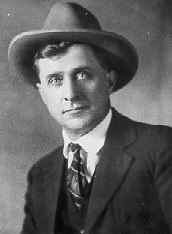
|
Luther Bishop - Agent
State Crime Bureau (OSBI) December 5, 1926
Luther Bishop was born in Arden, North Carolina in 1885. Luther served in the Navy and was discharged March 3, 1908. Luther Bishop married Edith Scovill on October 4, 1908. Edith was the daughter of Charles Scovill, town marshal of Cement, Oklahoma. A couple years later Luther and Edith moved to Britton, Oklahoma just north of Oklahoma City. Luther and Edith Bishop had a son named Leo who was born October 11, 1911. Luther Bishope became Britton town Constable. Luther later served as an Oklahoma City police detective before becoming one of the first agents hired for the Oklahoma Crime Bureau, now known as the Oklahoma State Bureau of Investigation.
About 2 a.m. on Sunday, December 5, 1926, loud noises, and gun shots were heard inside of agent Luther Bishop’s home at 1515 W. (NW) 28th in Oklahoma City. Luther Bishop’s fifteen year old son, Leo, and a neighbor went upstairs to investigate and found Agent Luther Bishop dead on the floor of the second-floor bedroom he shared with his wife, Edith.
Agent Luther Bishop had been shot seven times. Two shots were in his back with powder burns, indicating that they were fired from close range. At least two of the bullets were from a .44 caliber pistol. Luther Bishop also suffered bruises and a broken thumb and broken furniture in the bedroom indicated a violent struggle. Agent Luther Bishop’s two .44 caliber pistols, that were always kept close to his bed at night, were missing.
Luther Bishop’s two .44 caliber pistols were found the next day hidden in an upstairs linen closet and his wife Edith was arrested but was later acquitted and released following her trial.
No one was ever prosecuted for the murder of State Crime Bureau Agent Luther Bishop despite a one-thousand-dollar reward being offered.
Agent Luther Bishop was one of the main state investigators working with the FBI on the “Osage murders” at the time of his death.
Luther Bishop was forty-one years of age and is buried at Fairlawn Cemetery, Oklahoma City, Oklahoma County, Oklahoma.
In December 2011 State Crime Bureau Agent Luther Bishop was inducted into the Oklahoma Law Enforcement Hall of Fame.
OLEM – 8S-5-14 NLEOM – 43W7
Updated October 22, 2023
|
|
|
|
|
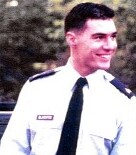
|
Shelby Dean Blackfox - Sergeant
Cherokee Nation Marshal Service November 6, 2001
The morning of Tuesday, November 6, 2001, Sergeant Shelby Blackfox met with Sergeant Garland Thompson and Investigator Donald Bowin of the Cherokee Nation Marshal Service (CNMS) regarding drug interdiction activity to be conducted that evening in Delaware County.
Sergeant Thompson approved Sergeant Shelby Blackfox to meet with a drug informant in Delaware County prior to the planned drug interdiction activity to be conducted that evening.
Sergeant Shelby Blackfox departed the CNMS office, located approximately four miles south of Tahlequah, at 11:10 a.m. on his motorcycle in route to Delaware County. At approximately 11:39 a.m., thirteen (13) miles north of Tahlequah on Highway 10, Sergeant Shelby Blackfox lost control of his motorcycle and was struck by a passenger vehicle resulting in Sergeant Blackfox’s death. Sergeant Blackfox was wearing a helmet and was not traveling at a high rate of speed when the accident occurred. He was pronounced dead upon arrival at a Tahlequah hospital.
His wife Jennifer and two-year-old son Trenton survived Sergeant Shelby Blackfoot and he is buried in Kansas Cemetery, Kansas, Delaware County, Oklahoma.
OLEM – 4S-2-20 NLEOM – 20E22
Updated September 7, 2023
|
|
|
|
|
|
Robert Turner "Bob" Blassingame - City Marshal
City of Wister July 3, 1928
On Thursday, June 17, 1928, two men attempted to rob City Marshal Robert Blassingame, 57, on the railroad platform in Wister. Marshal Blassingame broke free of the man who had grabbed his arms from behind, drew his gun and began a point-blank gun battle with the man facing him. One of the robbers fell dead after running only a few feet still holding a .32 caliber automatic pistol. The other robber was also wounded but escaped.
Marshal Robert Blassingame was wounded in the stomach and taken to a hospital in Fort Smith, Arkansas where he died Tuesday, July 3rd.
The dead robber was identified as James Adams alias James Gordon, 25. The other robber was arrested a few hours later and identified as Noland Gordon.
Robert Blassingame was survived by his wife Isabella A. (Deaton), 49, and two adult sons Robert Dixie, 28, and Henry Furman, 21.
Robert Blassingame is buried in Ellis Chapel Cemetery, Wister, Le Flore County, Oklahoma.
OLEM – 1N-3-5 NLEOM – 43W26
Updated September 7, 2023
|
|
|
|
|
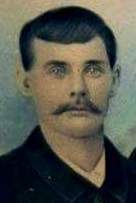
|
Edward A. Bohanon - Officer
U. S. Indian Police April 25, 1895
On Thursday, April 25, 1895, Officer Edward Bohanon, 32, was instructed by Indian Agent D. M. Wisdom to go to the home of a man named James Taylor four miles west of Durant in Blue County (Bryan County) in the Choctaw Nation to recover a yoke of stolen steers. Officer Edward Bohanon, in the company of Jack Turner, went to the James Taylor home that evening and they were met at the gate by Jim Jackson. Officer Edward Bohanon read the warrant then at almost the same time Jim Jackson and Officer Bohanon drew their guns and fired at each other. Officer Edward Bohanon fell dead with a bullet through his head, and Jim Jackson walked into the house and fell, where he soon died from a bullet through the breast.
Edward Bohanon was survived by his wife of five years, Rebecca, and a daughter Lucy.
Edward Bohanon is buried in the Bohanon Cemetery, north of Durant in Bryan County
OLEM – 10S-3-12 NLEOM –
Updated September 7, 2023
|
|
|
|
|
|
"Doc" Boley -City Marshal
City of Lima November 30, 1930
Marshal “Doc” Boley was a well-known and respected black officer in Lima, a small town six miles southeast of Seminole and in Seminole County. On Sunday, November 30, 1930, Marshal “Doc” Boley had arrested a young black man named Herbert Williams for larceny, at his home and was leading him out of the house when the man’s brother, Taft Williams came up behind them. As “Doc” Boley turned around, Taft Williams shot him in the left chest with a .410-gauge shotgun. Marshal Boley collapsed, and the two Williams brothers loaded Marshal Boley up in their car to take him to the hospital in Wewoka. The car broke down on the way and a passerby stopped and took Marshal Boley on into Wewoka to the hospital. City Marshal “Doc” Boley died as he was being taken into surgery.
The two Williams brothers were arrested later that night.
The burial site of “Doc” Boley is unknown.
OLEM – 5N-5-22 NLEOM –
Updated September 7, 2023
|
|
|
|
|
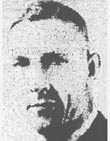
|
Ben L. Bolton - Chief of Detectives
Muskogee Police Department December 5, 1935
Ben Bolton was born in Texas on July 29, 1880. Ben Bolton began his law enforcement career as a Deputy Sheriff in Dallas County, Texas in 1912, where he served for six years. Ben Bolton was then employed by Swift and Company until he moved to Muskogee, Oklahoma in 1922 when he was employed by the MK&T Railroad as an officer. In 1928 Bolton joined the Muskogee Police Department and worked his way up through the ranks until he was appointed Chief of Police in 1932. In 1934, Bolton appointed Marsh Corgan as a Night Captain. In 1935 Ben Bolton was removed as Chief of Police and replaced by Marsh Corgan. Chief Corgan soon rehired Ben Bolton and appointed him Chief of Detectives.
On the morning of Tuesday, December 3, 1935, a mass jail break at the Muskogee jail was made by five members of the O’Malley gang of bank robbers and one petty thief who had armed themselves. As the prisoners neared the office of Chief Detective Ben Bolton, Chief Detective Bolton stepped from his office, saw the prisoners in the hall, stepped back into his office and got a submachine gun. As Detective Bolton stepped back to the door of his office, one of the prisoners, John Blackburn, aimed his shotgun over the shoulder of the guard he was shielded behind and fired at Detective Ben Bolton. Detective Bolton was hit in the face, just above the mouth, with a shotgun slug and fell without firing a shot. The prisoners picked up the submachine gun that had been dropped by Detective Bolton. The prisoners were involved in another shootout with officers in the station during which John Blackburn was killed, before making their escape.
Chief Detective Ben Bolton, 55, died from his shotgun wound later that night at 9:20 p.m.
Ben Bolton was survived by his second wife, Tillie Mae (Wessel), a stepson and a stepdaughter and is buried in Green Hill Cemetery, Muskogee, Muskogee County, Oklahoma.
OLEM – 7N-1-23 NLEOM – 16W24
Updated December 4, 2023
|
|
|
|
|
|
John R. Boston - Officer
U. S. Indian Police July 20, 1881
Officer John Boston, a full blood Cherokee, began tracking a gang of seven horse thieves from McAlester in early July of 1881. Officer Boston finally caught up with them on Wednesday, July 20th in the Chickasaw Nation, twenty miles northwest of Denison, Texas. Officer John Boston arrested two of the thieves with fourteen horses and started back with his prisoners. Officer John Boston was soon overtaken by the other five gang members and Officer John Boston was shot and killed.
The burial site of Officer John R. Boston is unknown.
OLEM – 10N-2-9 NLEOM – 2W19
Updated September 7, 2023
|
|
|
|
|
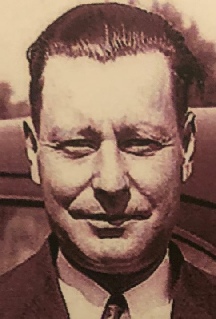
|
Raymond Thomas “Buck” Boston - Sheriff
Montgomery County (IL) Sheriff’s Office July 23, 1947
Montgomery County, Illinois Sheriff Raymond Boston, 41, and his driver, Deputy Sheriff Nick Fudoli, 27, had driven to Douglas, Arizona to pick up Roy E. Brashear, 49, former City Clerk of Litchfield, Illinois, who was wanted on a felony warrant issued on May 26, 1947, for embezzling $2,100 in city funds. Roy Brashear had been on the run since but gave himself up to Arizona officers and waived extradition back to Illinois on Sunday night, July 20, 1947, saying he was “tired of dodging”.
Sheriff Boston and Deputy Fudoli had taken custody of Brashear in Douglas, Arizona and were in route back to Illinois with him when about 9:15 p.m. Wednesday night, July 23, 1947, the sheriff’s new model car, driven by Deputy Nick Fudoli, was traveling at a high rate of speed east bound on U.S. Highway 66 west of Sayre, Oklahoma when it collided with a semi-trailer truck. Sheriff Raymond Boston and their prisoner Roy Brashear were killed in the crash. Deputy Sheriff Nick Fudoli was seriously injured but survived and the driver of the semi- trailer truck Dennis McCorley of Orange, Texas was not injured.
Sheriff Raymond Boston was three days short of his forty-second birthday when he was killed and was survived by his wife Isabel and four sons Raymond, Jr., 19, Robert, 17, Charles, 15, and Joseph, 9. Raymond Boston is buried in Saint Agnes Cemetery, Hillsboro, Montgomery County, Illinois.
OLEM – 10S-2-17 NLEOM –
Updated September 7, 2023
|
|
|
|
|
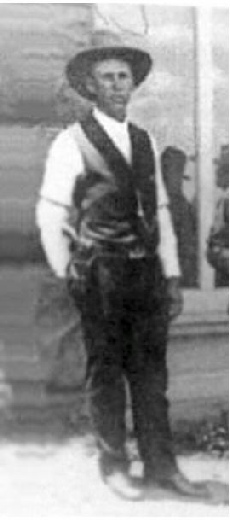
|
Lafayette Mathildred Boulware - Deputy Sheriff
Okfuskee County Sheriff’s Office January 18, 1917
On Thursday, January 18, 1917, Deputy Sheriff Lafayette Boulware, 59, was a member of a posse attempting to arrest a couple members of the Poe/Hart gang, wanted for a bank robbery in Harrah, hiding out in a farmhouse owned by Bob Williams, northeast of Boley.
The posse reached the Williams’ farmhouse while the bandits were still at breakfast. Not knowing this, the officers stopped and called Bob Williams out and asked him if he had seen two white men pass that way. At first Williams denied seeing the men, but soon said; "Yes, they are in the house now, but don't start any shooting around here." About that time the men rushed out the back door and began shooting as they ran out.
Jess Litterell, one of the bandits, dodged into a hen house and escaped the attention of the posse members for a short time. Russell Tucker, the other bandit, ran down into a
cotton patch, and was followed by part of the posse, Deputy Sheriff Lafayette Boulware in the lead. Boulware called several times for Russell Tucker to stop and surrender but was only
answered by more gun shots. Finally, Deputy Sheriff Lafayette Boulware shot at the bandit, one shot striking him exactly in the center of the forehead, killing him instantly. Several of the posse were shooting at Russell Tucker, and it is not known at this writing how many times he was struck, but it is conceded that it was one of the shots fired by Deputy Sheriff Lafayette Boulware that killed him.
This incident had attracted the attention of most of the members of the posse, and Jess Litterell, the bandit who had taken refuge in the hen house, was for a time unnoticed. When Deputy Sheriff Lafayette Boulware, however, started to go to the body of Russell Tucker, Jess Litterell, the concealed bank robber, opened fire on Deputy Sheriff Boulware and then called out; "Come to me, you son of a _____ !" Deputy Sheriff Boulware, however, had received three gun shot wounds, and only replied; "I can't come, I am killed." Deputy Sheriff Boulware then fell and died a few minutes later.
The remainder of the posse engaged in a gun battle with Jess Litterell until he was wounded three times and surrendered. Jess Litterell was convicted of the murder of Deputy Sheriff Boulware and sentenced to life in prison. He also was sentenced to twenty-five years in prison for the bank robbery in Harrah. Jess Litterell was also charged with but never tried for the ambush killing earlier that same January of Charles Bullock, City Marshal of Delaware and his Posse John Garritson.
Deputy Sheriff Lafayette Boulware was survived by and his second wife Jessie P. (Bishop – McCleary) whom he had recently married, and his three sons, George Barney, 26, Charles Henry, 24, and John “Emory”, 10. Lafayette Boulware’s first wife, Celia Francis (Cain) had died of Typhoid Fever five months earlier in August of 1916.
Lafayette Boulware is buried in Castle Cemetery, Castle, Okfuskee County, Oklahoma.
OLEM – 8S-1-11 NLEOM – 12E22
Updated January 17, 2024
|
|
|
|
|
|
John Joseph Bouquot – Sheriff
Woodward County Sheriff’s Office - Not Line of Duty
John Bouquot was born in Iowa in August 1869. In 1882 his family moved to Ashland, Kansas. In 1893 John Bouquot married Anna Josephine Knittel at Riverside, Iowa. Soon after their marriage John and Anna with the opening of the Cherokee Strip, moved to Curtis, Oklahoma Territory, where they homesteaded on their farm, one mile north of what is now the town of Mooreland. The Bouquots had nine children.
John Bouquot was the first elected Sheriff of Woodward County after Oklahoma became a state in November 1907. John Bouquot lost his bid for re-election as Sheriff in 1911. In November 1924 John Bouquot was again elected Sheriff of Woodard County taking office January 5, 1925. In late May 1927 Sheriff Bouquot, 57, had gone to Iowa to recover a stolen car and was returning with the stolen car when he became ill and had to stop at St. Francis Hospital in Wichita, Kansas. John Bouquot underwent surgery on June 2nd for a hernia and died during surgery.
John Bouquot was survived by his wife and six daughter and two sons.
John Bouquot’s wife Anna was appointed Sheriff of Woodward County to finish the remainder of her husband John’s term.
John Bouquot and his wife Anna are buried in Saint Joseph Catholic Cemetery, Mooreland, Woodward County, Oklahoma.
John Bouquot’s death is not considered a line of duty death.
Updated June 11, 2021
|
|
|
|
|
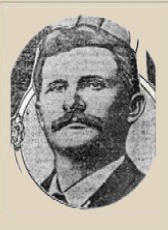
|
James C. Bourland - Deputy U.S. Marshal/Deputy Sheriff
U. S. Marshal Service / Caddo County, O.T. May 24, 1906
James C. Bourland’s real name was Will Wade, and he was a former outlaw turned law-abiding citizen. He had been in prison but was pardoned. In 1902 James Bourland was appointed a Deputy U.S. Marshal by U.S. Marshal Bill Fossett. James Bourland was also serving as a Caddo County Deputy Sheriff.
William Wesley “Fred” Hudson had also been an outlaw but was made a Deputy U.S. Marshal to infiltrate the Bert Casey gang. William Hudson was working undercover and was part of the gang when they found out Luther “Lute” Houston, 19, another member of the gang, was also an undercover Deputy U.S. Marshal. Deputy “Lute” Houston was hung, and his body filled with bullets in late October 1902.
A month later “Fred” Hudson shot and killed Bert Casey and gang member Jim Simms as the gang was camped near Cleo Springs planning another train robbery.
Deputy Marshal James Bourland was still investigating the murder of Deputy Marshal Lute Houston and obtained a murder warrant for “Fred” Hudson. Deputy Marshal Bourland arrested Hudson in Arkansas and brought him back to Oklahoma where he was tried but acquitted of the murder of Deputy Marshal “Lute” Houston in early May 1906. There had been hard feelings between Deputy Marshal Bourland and “Fred” Hudson for some time even before the arrest.
The afternoon of Tuesday, May 22, 1906, Deputy Marshal James Bourland arrested “Fred” Hudson for carrying a gun in Anadarko. “Fred” Hudson was arraigned, bond set, he posted bond and was released from jail. The next time the two men saw each other was in Robinson’s Saloon in Anadarko at 1 a.m. the next morning, Wednesday, May 23rd. No words were spoken but both men immediately went for their guns. Deputy Marshal Bourland was shot in the stomach while “Fred” Hudson was shot in both thighs. Deputy Marshal Bourland was operated on and three feet of intestines that were pierced in multiple places by bullet fragments, were removed. Deputy Marshal James Bourland died at 6:30 a.m. on Thursday, May 24 at the age of 35.
Deputy Marshal James Bourland was unmarried and is buried in Anadarko, but his exact burial site is unknown.
Doctors also had to amputated one of “Fred” Hudson’s legs and he died Friday, May 25th the day after Deputy Marshal James Bourland.
OLEM – 5N-4-2 NLEOM – 50W2
Updated September 7, 2023
|
|
|
|
|
|
C. L. Bowden – Deputy U.S. Marshal
U.S. Marshal Service - Not Line of Duty
Newspapers reported on June 19, 1891, that Deputy Marshal C. L. Bowden’s body was found between Tahlequah and Braggs with several bullet wounds. Deputy Marshal C. L. Bowden had earlier written a letter to U.S. Marshal Yoes stating that he was searching for Ned Christi for the murder of Deputy Marshal Dan Maples. It was believed that Ned Christi had also killed Deputy Marshal Bowden.
However, reports of Deputy Marshal C. L. Bowden’s death were false, and he continued serving as a deputy marshal for several more years. C. L. Bowden’s deputy marshal commission was renewed on October 27, 1894.
There is no record of Deputy Marshal C. L. Bowden’s death after his commission was renewed.
OLEM – 5N-3-9
Updated February 23, 2022
|
|
|
|
|
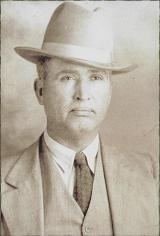
|
Claude James "CJ" Bowen - Captain
Shawnee Police Department August 13, 1935
Claude Bowen at 6’4” and 250 pounds was known as big and tough, and quick on the draw. Claude Bowen began his law enforcement career as a Special Agent for the Rock Island Railroad before joining the Shawnee Police Department in 1924 through 1927. Claude Bowen then joined the Pottawatomie County Sheriff’s Office for two years. In 1929 Bowen resigned the sheriff’s office and went back to work for the Shawnee Police Department.
Shortly before 6 p.m. on Thursday, May 31, 1934, Captain Bowen and Detective Robert Warlick, 37, were returning from a call in the eastern part of Shawnee when their 1930 Chevrolet patrol car collided with another car that failed to stop for a stop sign at East Highland and Harrison Ave. The patrol car then hit a tree. Detective Robert Warlick was crushed into the steering wheel and Captain Claude Bowen was ejected from the car, striking a fire plug with his head causing a fractured skull and he suffered a broken right shoulder.
Detective Robert Warlick died shortly after arriving at the hospital.
Captain Claude Bowen died just over a year later, on Tuesday, August 13, 1935, at age 51, from complications from the injuries he sustained in the accident.
Captain Claude Bowen was survived by his wife Kate and three daughters and is buried in Tecumseh Cemetery, Tecumseh, Pottawatomie County, Oklahoma.
OLEM – 7N-2-16 (Claud Bowan) NLEOM – – –
Updated August 13, 2023
|
|
|
|
|
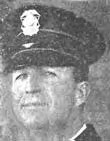
|
Abraham Lincoln "Link" Bowline - Patrolman
Tulsa County Highway Patrol August 29, 1929
On the afternoon of Thursday, August 29, 1929, Tulsa County Highway Patrolman Abraham “Link” Bowline, 39, and his partner, Captain Ross Darrow, 42, attempted to stop a yellow Chevrolet sedan that was fleeing the scene of a traffic accident.
Patrolman Bowline had jumped on the running board of the fleeing vehicle which soon pulled into Newblock Park on the Sand Springs Road with Patrolman Ross Darrow following close behind in their patrol vehicle. Captain Ross Darrow pulled the patrol car in front of the yellow Chevrolet.
The occupants of the fleeing car were escaped bank robber Dick Gregg and two members of his gang. As the two cars came to a stop, Patrolman Abraham Bowline started getting Dick Gregg out of the driver’s seat at gun point when Dick Gregg pulled a .45 caliber pistol and shot Patrolman Abraham Bowline in the heart killing him.
Captain Ross Darrow then exchanged shots with the gang members during which he and Dick Gregg were both shot and killed.
Patrolman Abraham “Link” Bowline was survived by his wife Harriet, a son Edward 4, and two daughters Belinda 2 and Martha 7 months.
Abraham Bowline is buried in Memorial Park Cemetery, Tulsa, Tulsa County, Oklahoma.
OLEM – 8S-5-8 (Bowlin) NLEOM – 52W22
Updated August 29, 2023
|
|
|
|
|
|
Charles Wilson Bowman, Captain
Muskogee Police Department June 6, 1927
While patrolling shortly after midnight on Sunday, June 5, 1927, Captain Charles Bowman, 51, and Chief of Police Clark Compton found a Ford parked in the driveway of a service station at Fredonia Street and East Side Boulevard.
Suspecting a burglary, the two officers approached the car with guns drawn. Captain Charles Bowman went to the front seat as Chief Clark Compton went to the back seat and woke up the two men asleep inside. R. C. Hansel was in the front seat and Grover Stewart was in the back seat. The two men in the car began fighting with the officers during which R. C. Hansel kicked Captain Bowman’s gun hand causing the gun to discharge. The bullet struck Captain Charles Bowman in the right leg severing an artery causing him to quickly bleed to death.
R. C. Hansel and Grover Stewart were both arrested and charged with transporting whiskey and resisting arrest, but the county attorney said that the evidence indicated the shooting was an accident and refused to charge either of the men with manslaughter.
Captain Charles Bowman had served with the Muskogee Police Department for sixteen years and left behind his wife Maggie, a daughter and two sons.
Captain Charles Bowman is buried in Greenhill Cemetery, Muskogee, Muskogee County, Oklahoma.
OLEM – 8S-3-15 (C A Bowman) NLEOM – 40W26
Updated September 7, 2023
|
|
|
|
|
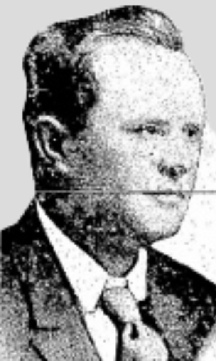
|
Robert Leo Bowman - Special Prohibition Agent
U. S. Department of Interior September 19, 1912
Agent Robert Bowman was charged with enforcement of U.S. liquor laws in Eastern Oklahoma. On Thursday, September 19, 1912, Agent Robert Bowman and William R Mayfield, City Marshal of Lenepah had set up a check point about one mile south of the Kansas border. About 4 p.m. the officers observed four horse drawn wagons headed south. The officers stopped the four wagons; found they were each carrying liquor and arrested the four drivers. Agent Robert Bowman then climbed on the wagons to start destroying the booze while City Marshal Mayfield kept a watch on the four prisoners. Unknown to the officers, two cars had been following the wagons as guards. As the two cars approached, their occupants opened fire on the two officers with rifles and shotguns instantly killing Special Agent Robert Bowman and wounding City Marshal William R. Mayfield.
Special Agent Robert Bowman was survived by his parents and is buried in Oakland Cemetery, Tulsa, Tulsa County, Oklahoma.
City Marshal William R. Mayfield survived his four bullet wounds. On January 19, 1926,
William R. Mayfield was working as a Supervisor at the Oklahoma State Penitentiary brick yard in McAlester when he was attack by a prisoner with a brick and died from his head injury the next day, January 20, 1926.
OLEM – 4S-1-10 NLEOM – 54E18
Updated January 26, 2024
|
|
|
|
|
|
A. J. Boyd - City Marshal
City of Langston May 11, 1900
The morning of Friday, May 11, 1900, Enoch H. Armstead got in a fist fight with another black man named English over the ownership of some chickens. During the fight Enoch Armstead drew a revolver when City Marshal A. J. Boyd, 51, came upon them, took the gun away from Armstead, stopped the fist fight, separated the two men, and sent the two men on their separate ways.
A short time later Enoch Armstead met City Marshal Boyd and asked for his gun back. Marshal Boyd refused saying that Armstead was a dangerous man. The request by Enoch Armstead was renewed with some hot words. Enoch Armstead left the area and went to his home, procured a Winchester rifle, and then hunted for City Marshal A. J. Boyd. When Armstead found Marshal Boyd, he asked for his gun and again Marshal Boyd refused to give it to him. Enoch Armstead then shot Marshal Boyd with the bullet penetrating his breast at a point opposite the apex of the heart, killing him instantly.
Enoch Armstead tried to get away but was captured by friends of the dead marshal. Mob violence against Armstead was hinted but was averted. Enoch Armstead was then taken to the Logan County jail in Guthrie under heavy guard.
Marshal A. J. Boyd was survived by his wife, a son, and a daughter and is buried in Beaulahland Cemetery, Langston, Logan County, Oklahoma.
Enoch Armstead admitted to the murder of City Marshal A. J. Boyd before a judge and at Armstead’s request accepted a life in prison sentence without a hearing.
OLEM – 10S-3-8 NLEOM –
Updated September 7, 2023
|
|
|
|
|
|
Joe Boyle – Posse for Deputy U.S. Marshal
U. S. Marshal Service - Not Line of Duty
On Jun 21, 1896, Deputy U.S. Marshal Charles N. Dugger and his Posse Joe Boyle were reported to have been shot and killed in the Osage Nation by whiskey peddlers the day before.
The report stated that Joe Boyle was about thirty years old and from Missouri.
A few days later a letter was received from Deputy Marshal Charles Dugger stating that he was very much alive in Caney, Kansas and would be home in Pawnee, Indian Territory in a few days. Posse Joe Boyle was also very much alive.
Charles N. Dugger and Joe Boyle’s names were mistakenly engraved on the Oklahoma Peace Officers Memorial in 1969.
OLEM – 3S-1-7
June 21, 2022
|
|
|
|
|
|
George W Bradley - Deputy City Marshal
City of Caney December 9, 1920
George Bradley, 71, had been section foreman at Caney for the Katy Railroad for thirty-seven years. About 11 p.m. Thursday, December 9, 1920, the Caney City Marshal discovered three young men in the waiting room at the railroad depot that he suspected of being implicated in several robberies in that section. City Marshal deputized George Bradley to assist him in making the arrests. The City Marshal went to one of the doors and sent Deputy Bradley to the other door. One of the men, Harry Young, started out of the door where the City Marshal was, and the marshal nabbed him. The other two men went out the other door, meeting Deputy Bradley. Without a word of warning, one of the men opened fire on Deputy Bradley. The bullet entered his heart and he expired before medical attention could be given him. Deputy Bradley had a pistol in his hand and later it was found that one of the shells had been exploded, but whether it struck one of the robbers is not known. The two men then made their escape.
George Bradley’s body was embalmed and taken to Caddo for interment on Saturday afternoon. George Bradley was a widower and was survived by his three adult daughters Jocie, Ada and Helen.
George Bradley is buried in the Gethsemane Cemetery, Caddo, Bryan County, Oklahoma.
Harry Young of Fort Worth, who was captured by the City Marshal, confessed to the robbery of the Tushka Depot and of the freight train a few mornings earlier. He stated that “Jeff” Jefferies, who lives somewhere in the east, did the shooting and that the man who escaped with him was Jake L. Price or Jake Watson. Both escaped men were later arrested. Irving T. “Jeff” Jefferies was convicted of the murder of Deputy Marshal George Bradley and sentenced to life in prison.
OLEM – 10S-3-11 NLEOM –
Updated September 7, 2023
|
|
|
|
|
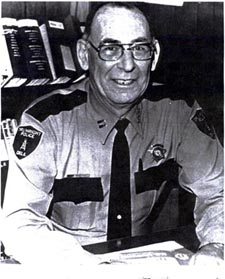
|
James Alexander Bradley - Officer
Oilton Police Department April 29, 1985
About 10 p.m. on Monday, April 29, 1985, Officer James Bradley, 66, was directing traffic due to a fatality traffic accident on rain slick Highway 51, one and a half miles east of Drumright when he was struck by a 1974 Ford wrecker that was responding to the original accident. Officer James Bradley was dead on arrival at the hospital from massive head injuries.
Officer James Bradley had been an Oilton officer for five years and had served thirteen years as Chief of Police of Drumright prior to joining the Oilton Police Department.
Officer James Bradley was survived by his wife Colleen and is buried in Fairview Cemetery, Cushing, Payne County, Oklahoma.
OLEM – 2N-2-8 NLEOM – 54W1
Updated September 7, 2023
|
|
|
|
|
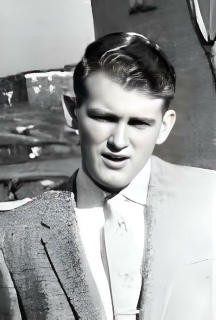
|
George Lee Brady - Officer
Tulsa Police Department April 3, 1963
George Lee Brady was born in Oklahoma County, Oklahoma on July 3, 1940, to Fred H. and Evelyn V. (Bell) Brady.
Officer George Brady, 23, was killed on Wednesday, April 3, 1963, when he was involved in a traffic accident during a high-speed pursuit south from the 1500 block of North Lewis Avenue. A vehicle pulled in front of Officer George Brady’s speeding police car causing Bradley to go left of center to avoid the vehicle and the police car struck another vehicle head on. Officer George Brady died at the scene of the accident.
Dorothy Amsey, 38, a passenger in the vehicle Officer Brady struck was also killed. Her husband William, who was driving, was injured but not critically.
The vehicle Officer Brady was pursuing wrecked later and the sixteen-year-old driver was apprehended.
Officer George Brady was survived by his parents and is buried in Memorial Park Cemetery, Tulsa, Tulsa County, Oklahoma.
OLEM – 7N-5-11 NLEOM – 28W10
Updated September 7, 2023
|
|
|
|
|
|
John Branson - Deputy Sheriff
Mayes County Sheriff’s Office August 15, 1911
On Sunday, August 13, 1911, Deputy John Branson and another deputy named Sanders were transporting a prisoner named H. Gleason, who they had arrested in Adair for bootlegging, to Pryor Creek in a one-horse buggy.
About one mile north of Pryor Creek the horse was spooked by a passing train and began to run. The buggy turned over and Deputy John Branson suffered a severe head injury. Deputy Sanders was also injured. The prisoner hailed another buggy and transported the two injured deputies into Pryor Creek. Deputy John Branson remained unconscious until his death two days later on Tuesday, August 15th.
Deputy Sanders survived his injuries.
After delivering the deputies for treatment H. Gleason turned himself in to the Pryor Creek Chief of Police.
The burial site of John Branson is unknown.
OLEM – 4S-3-10 NLEOM – 48E23
Updated August 14, 2023
|
|
|
|
|
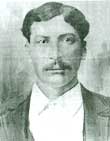
|
Benjamin Franklin Brashears – City Marshal
Panama City May 19, 1919
About 4 a.m. Monday morning, May 19, 1919, City Marshal Benjamin Brashears was called to search for a burglar in the business district of Panama City in Le Flore County. A local merchant named Frank Massey was also called and told that someone was trying to burglarize his store. Frank Massey armed himself with a shotgun and proceeded to his store. Seeing a shadowy figure near his store, Frank Massey fired, fatally injuring Marshal Benjamin Brashears, having mistaken him for the burglar.
Marshal Benjamin Brashears was survived by his wife Myrtle B. (Lipsey) and two teen aged children and is buried in Fairview Cemetery, Panama, Le Flore County, Oklahoma.
OLEM – 9N-2-7 NLEOM – 15W6
Updated September 7, 2023
|
|
|
|
|
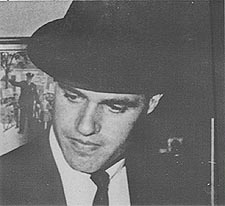
|
Gerald Wayne "Jerry" Bratcher - Lieutenant
Norman Police Department November 24, 1963
Gerald Wayne Bratcher was born July 30, 1934, in McComb, Oklahoma to Elijah Wesley and Florence Ida (Ginn) Bratcher.
Gerald “Jerry” Bratcher joined the Norman Police Department on February 13, 1958. Gerald Bratcher served as a patrolman and a motorcycle officer before being promoted to Detective Sergeant in July of 1961. In April 1963 Gerald Bratcher was promoted to Detective Lieutenant.
About 4 p.m., Sunday, November 24, 1963, Lieutenant Gerald “Jerry” Bratcher was traveling west three miles east of Norman on Highway 9 returning from a stolen car investigation when he was involved in an automobile accident when another car turned in front of his police unit. Both occupants of the other car and Lieutenant Bratcher were ejected from their vehicles. Lieutenant “Jerry” Bratcher and the driver of the other vehicle, Gerald Wesley Byram, 20, died from their injuries after arriving at St. Anthony’s Hospital in Oklahoma City.
Lieutenant Gerald Bratcher, 29, was survived by his wife, a son and two daughters and is buried in the IOOF Cemetery, Norman, Cleveland County, Oklahoma.
OLEM – 7N-4-21 NLEOM – 63W2
Updated September 7, 2023
|
|
|
|
|
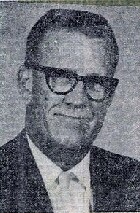
|
Burton Lee Brewer - Deputy Sheriff
Okmulgee County Sheriff’s Office July 25, 1974
Burton Brewer served as an Okmulgee Firefighter for twenty-one years before retiring and becoming a private detective in Tulsa for a short time before joining the Okmulgee County Sheriff’s Office as a Deputy in 1973.
By Thursday, July 25, 1974, Deputy Sheriff Burton Brewer, 57, had been a Deputy Sheriff for ten months. Shortly before midnight that night Deputy Sheriff Burton Brewer and Buck Grace, Chief of Police at Morris, went to a house in Schulter where Darrell Andrews, 20, who had shot and killed Dewar Police Officer Thomas C. Adkins and Henryetta Auxiliary Police Officer Walter T. Hembree earlier that night, was “holed up.”
Unknown to the officers Darrell Andrews had gotten out of the house and was in the shadows of tall grass by a fence in the back yard. As Deputy Sheriff Burton Brewer and Chief Buck Grace approached the house Darrell Andrews stood up and fired a 12-gauge shotgun at Deputy Sheriff Burton Brewer killing him. Chief of Police Buck Grace then wounded Darrell Andrews and he was taken into custody.
Darrell Andrews was charged with three counts of First-Degree Murder in the deaths of the three officers and later sentenced to life in prison.
Deputy Sheriff Burton Brewer was survived by his wife Gracine and is buried in Okmulgee Cemetery, Okmulgee, Okmulgee County, Oklahoma.
OLEM – 1N-3-15 NLEOM – 12W18
Updated September 7, 2023
|
|
|
|
|
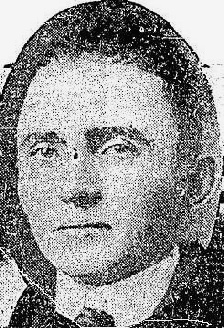
|
Howard Orville “Pete” Brewer - Deputy Sheriff, Motorcycle Patrolman
Oklahoma County Highway Police
Oklahoma County Sheriff’s Office March 18, 1926
The afternoon of Thursday, March 18, 1926, Officer Howard Brewer, 26, was on his county motorcycle west bound on New Castle Road (Highway) in Oklahoma City. As he approached G Street (later SW 29th Street) an east bound touring car driven by H. Stewart turned left in front of Officer Brewer. Officer Brewer’s county motorcycle left 100 feet of skid mark before striking the right front passenger side of Stewart’s car. Brewer’s motorcycle was demolished and caused major damage to Stewart’s car. Officer Howard Brewer was first transported by a witness, E. E. Leonard, two miles to an ambulance then to a hospital where he died.
H. Stewart was slightly injured and arrested at the scene by Oklahoma City Police motorcycle officer Guy Mitchell pending charges of Manslaughter. H. Stewart was released that night after posting $5,000 bond. Charges against H. Stewart were later dismissed by Oklahoma County District Attorney K. D. Mitchell on March 22, 1926.
Howard Brewer had been commissioned as an Oklahoma County Deputy Sheriff and County Highway Police Officer on February 15, 1925, just over one year before the fatal accident and was survived by his wife of five years, Alma (Caldwell).
Deputy Howard Brewer is buried in the Tonkawa IOOF Cemetery in Tonkawa, Kay County, Oklahoma.
OLEM – 10N-1-10 NLEOM – 57W29
Updated September 7, 2023
|
|
|
|
|
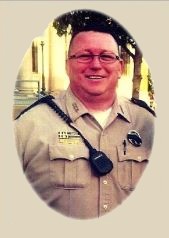
|
William Harold “Bill” Briggs - Corporal
Creek County Sheriff’s Office January 17, 2018
On Sunday morning, December 10, 2017, Corporal William Briggs, 49, began his patrol shift as a Field Training Officer (FTO) just before 7 a.m. with Deputy Dave Shelby as his trainee. Corporal Briggs ended his shift that Sunday at 3:22 p.m. that afternoon.
Corporal William Briggs later advised his wife Kim that he had experienced blurred vision during his shift. At 8:30 p.m. that Sunday evening Corporal Briggs suffered a stroke and was admitted to the hospital where he remained until his death on January 17, 2018.
William Briggs had been a law enforcement officer for fourteen years and was survived by his wife Kim and two children.
William Briggs is buried in South Heights Cemetery, Sapulpa, Creek County, Oklahoma.
OLEM – 4N-1-17 NLEOM – 54W31
Updated September 7, 2023
|
|
|
|
|
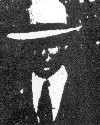
|
William Sydney Brooks - Patrolman
Tulsa Police Department December 31, 1930
On Saturday, December 27, 1930, William Brooks had only been a Tulsa Police Officer two months. On that Saturday Motorcycle Officer William Brooks, 39, was escorting an ambulance which was transporting a man wounded by another Tulsa officer. A vehicle pulling a trailer pulled in front of Officer Brooks at the Sapulpa Highway and Carbondale Road in Oakhurst causing Officer Brooks’ police motorcycle to collide with the trailer.
Patrolman William Brooks died Wednesday, December 31, 1930, from his head injuries suffered in the collision leaving behind a wife and six children.
William Brooks is buried in Woodlawn Cemetery, Poplar Bluff, Butler County, Missouri.
OLEM – 7N-1-2 NLEOM – 28W1
Updated September 7, 2023
|
|
|
|
|
|
John M. Brown - Lieutenant
Cherokee Nation Lighthorse December 28, 1845
In the late 1830’s, when the Cherokees relocated from the eastern United States to
Indian Territory, part of the tribe did so voluntarily under the leadership of Major Ridge.
Another part of the tribe under Chief John Ross was moved to the Indian Territory by force.
In the mid-1840’s James Starr and his sons were among the more violent supporters
of Major Ridge. James Starr and his gang rode roughshod over the territory, intimidating voters and election officials, murdering and stealing horses.
On Friday, September 15, 1843, brothers Bean, Ellis, Tom, and Washington Starr along
with Arch Sanders assassinated a Ross spy named Kelly.
Later that same Friday, they murdered a Ross sympathizer named Benjamin Vore,
his wife, five-year-old son and a stranger who had stopped at the Vore house located on
Military Road about thirty (30) miles from Fort Gibson.
The Ross Council offered a reward of $1,000 for each member of the Starr gang
who had for a while escaped into Arkansas.
In the fall of 1844, the Starr gang, led by Bean Starr, was driving some stolen horses south toward Texas when they were approached by a posse of twenty-five Cherokee Nation Lighthorse police officers about twenty-five miles north of Fort Washita in the northern part of what is now Bryan County. Lt. John Brown killed the gang leader, Bean Starr in the ensuing gun battle.
On Sunday, December 28, 1845, Charles Smith, a friend of Bean Starr and who had been riding with the gang when Bean was killed, saw John Brown working in his black smith shop and stabbed John Brown to death. John Brown had resigned from the Cherokee Lighthorse sometime before being killed because of his actions as a law enforcement officer.
Charles Smith was located a short time later in early January 1846 and killed by other Lighthorse officers when he resisted arrest.
The burial site of John Brown is unknown.
John Brown is currently the oldest known law enforcement line of duty death in Oklahoma.
OLEM – 4S-2-30 NLEOM – 35W23
Updated September 7, 2023
|
|
|
|
|
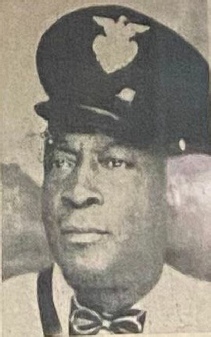
|
King Charles Brown - Officer
Lawton Police Department January 21, 1946
King Charles Brown was born in Texarkana, Arkansas, October 30, 1897, and came to Lawton in 1913 when he was sixteen years old.
Officer King Brown, 48, was one of Lawton’s black officers and had joined the Lawton Police Department in July 1944. Officer King and two other officers, Fred Sullivan and L. B. Ferris had been called to a nightclub on First Street early the morning of Sunday, January 20, 1946, in reference to a shooting. Two men were arrested at the scene. Officer King Brown then got back in his police car and was placing his revolver back in his holster when the gun accidentally discharged. The bullet went through the lower part of Officer Brown’s stomach. Officer Brown was taken to a local hospital where he was operated on but died the next morning Monday, January 21st.
Officer King Brown’s first wife had died several years earlier. He was survived by his second wife of less than a year, Florida Ophelia (Jones) and a daughter and is buried in Highland Cemetery, Lawton, Comanche County, Oklahoma.
OLEM – 7N-2-18 NLEOM – 50E7
Updated September 7, 2023
|
|
|
|
|
|
Leander Brown - Private
U. S. Indian Police August 7, 1882
Late in the day of Sunday, August 6, 1882, Private Leander Brown, a Wyandotte Indian, arrested Thomas Keener for failure to have a permit to be on Indian land or to cut hay there after Private Brown had already told him to leave earlier in the day.
Private Leander Brown took Thomas Keener to the Quapaw Agency offices in the northeast part of what is now Ottawa County, to spend the night then take him to the Fort Smith Federal Court the next morning. Private Leander Brown slept in a room in the offices with Thomas Keener. Sometime during the early morning hours of Monday, August 7th, while Private Leander Brown slept Thomas Keener slipped his shackles, struck Private Brown in the head and a fight ensued. During the fight Thomas Keener was able to grab a pick, described as an “ink eraser”, which was laying on the desk in the room, and plunge it into Private Leander Brown’s left chest area several times, killing him almost instantly. Thomas Keener then escaped.
Thomas Keener was arrested two weeks later at his father’s home in Newton County, Missouri and taken to the federal court in Fort Smith, Arkansas for trial. Since Thomas Keener was a white man, he was tried in Judge Isaac Parker’s federal court. Thomas Keener was found not guilty by reason of insanity by a jury and released.
The burial site of Private Leander Brown is unknown.
OLEM – 10S-2-11 NLEOM – 11E24
Updated August 6, 2023
|
|
|
|
|

|
Paul Gregory Broxterman - Criminal Investigator
Office of Inspector General
U.S. Department of Housing and Urban Development April 19, 1995
Paul Broxterman, 43, was born Paul Ramsey Beatty, III. He was assigned to the Department of Housing and Urban Development office on the fifth floor of the Alfred P. Murrah Federal Building in Oklahoma City only two days before dying in the bombing of the building on Wednesday, April 19, 1995.
Paul Broxterman had served in the Navy 1971 to 1977 spending part of that time in Viet Nam as a radio man for the USS Enterprise. He later worked as a tax examiner for the Internal Revenue Service, as a criminal investigator for the Bureau of Indian Affairs and as a Special Agent for the U.S. Department of Agriculture. Paul Broxterman was a member of the Pottawatomie Tribe and active in American Indian activities.
Investigator Paul Broxterman was survived by his wife, Cammy, sons Aaron and Jerod and daughter Cassandra.
Paul Broxterman is buried in Mount Hope Cemetery, Topeka, Shawnee County, Kansas.
OLEM – 2N-3-21 NLEOM – 38W20
Updated September 7, 2023
|
|
|
|
|
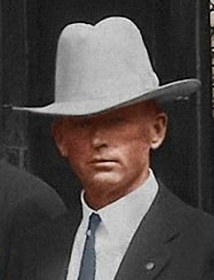
|
Shepard E. "Shep" Brumley - Officer
Sapulpa Police Department January 1, 1923
Shepard Brumley was born March 28, 1880, in Miller, Lawrence County, Missouri to John Harrison and Julia S. (Shelton) Brumley. In 1908 Shepard Brumley married eighteen-year-old Mollie E Hazelwood.
About 9:45 p.m. Monday, January 1, 1923, an anonymous caller reported a disturbance at 223 North Hickory and requested that Chief Ralph Morey come with the responding officers. Officers “Shep” Brumley and Hildreth were assigned the call plus three other officers were sent as it was in the “colored section” of the city.
Upon arrival the officers found the address to be a vacant lot. They then went to the restaurant next door in hopes of getting more information. As the five officers walked upon the porch of the restaurant, the lights inside were turned off, silhouetting the officers against the porch light. Immediately, a volley of gunfire erupted from inside the restaurant. All five officers were wounded and a wound to the head from a 30-30 rifle killed Officer Shepard Brumley instantly.
Shepard Brumley was survived by his wife Mollie and their four children, Goldie Virginia, 12, Mary Ethel, 10, Carl Shepard, 5, and Bertha Madeline, 2.
Shepard Brumley is buried in Kellyville City Cemetery, Kellyville, Creek County, Oklahoma.
Ed Glass was charged with the murder of Officer Shepard Brumley.
OLEM – 8S-2-23 NLEOM – 54W14
Updated September 7, 2023
|
|
|
|
|

|
Thomas Jefferson Brumley - Chief
Sapulpa Police Department February 3, 1934
On Saturday, February 3, 1934, about 3:30 p.m. Chief Thomas Brumley, Creek County Sheriff Will Strange and two other officers were checking for armed robbery suspects on a tip that they were hiding out in “a little white house north of Sapulpa.” As the officers approached the third white house to be checked out, they observed several men running away from the windows. The officers surrounded the house with Chief Thomas Brumley covering the rear. As two of the men were walking out the front door to the officers, a shot was heard from the rear of the house. At that moment, the officers and the two men drew guns, but the officers were quicker and shot the two men before they could fire. One man was killed instantly, and the other died the next morning. Officers then ran to the rear of the house and found Chief Thomas Brumley shot dead. Apparently a third man, fugitive bank robber Dupert Carolin, had been hiding in the cellar and shot Chief Brumley. The officers then became involved in a running gun battle with Carolin wounding him before he escaped into the rocks and hills surrounding the rural house. Dupert Carolin soon after killed Sapulpa Officer Charles P. Lloyd before being killed by other officers.
Chief Thomas Brumley was survived by his wife Letha E. (Boren) and eleven children and is buried in Kellyville City Cemetery, Kellyville, Creek County, Oklahoma.
Chief Thomas Brumley’s brother Shepard had also died in the line of duty as a Sapulpa police officer in 1931.
OLEM – 7N-1-15 NLEOM – 28W6
Updated September 7, 2023
|
|
|
|
|
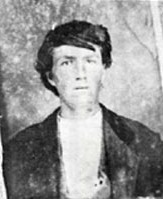
|
Eli Hickman “Heck” Bruner - Deputy U.S. Marshal
U. S. Marshal Service June 21, 1899
On Wednesday, June 21, 1899, Deputy Marshal Eli “Heck” Bruner, 40, had thirteen (13) arrest warrants from the Muskogee Federal Court to serve east of the Grand River. Deputy Marshal “Heck” Bruner was in a hurry to serve the warrants while the court was still in session. When Deputy Marshal Bruner and his posse arrived at the West’s Ferry Crossing near Spavinaw they found that the ferry was on the other side and the ferryman was gone. Deputy Marshal Bruner took his clothes off and attempted to swim across the rain swollen river to get the ferry and bring it back over for his team but drowned before reaching the other side.
The body of Deputy Marshal “Heck” Bruner was not recovered until the next day.
His wife Laura and three children in Pryor Creek survived Deputy Marshal Eli “Heck” Hickman and he is buried in Graham Memorial Cemetery, Pryor, Mayes County, Oklahoma.
In December 2012 Deputy U.S. Marshal Eli Hickman “Heck” Bruner was inducted into the Oklahoma Law Enforcement Hall of Fame.
OLEM – 4S-2-9 NLEOM – 3E11
Updated September 7, 2023
|
|
|
|
|
|
Robert B. "Bob" Bryant - Deputy Constable
City of Depew October 21, 1911
On Saturday, October 21, 1911, Judge Hacker of Depew deputized Noah Craig, Willis Craig, and Bob Bryant to arrest one of Offlie Page’s five sons on a charge of wife beating.
The three new deputy constables then went to the Page home and as they entered, two of the sons had them covered with guns. Deputy Constable Willis Craig grabbed one of the guns, a struggle ensued, and shots were fired from inside and outside of the house. Deputy Constable Bob Bryant was fatally wounded.
All the members of the Page family were arrested and charged with murder. Fourteen guns were confiscated from the Page home.
Robert Bryant is buried in Bailey Memorial Cemetery, Depew, Creek County, Oklahoma.
OLEM – 4N-3-11 NLEOM –
Updated September 14, 2023
|
|
|
|
|
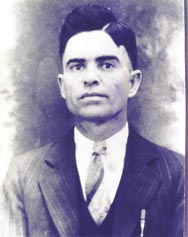
|
Jason Victor "Vic" Buchanan - Officer/Special Agent
Hugo Police Department / Frisco Railroad Police December 19, 1931
Officer Jason Buchanan and Hugo Special Officer Sterling Jackson were patrolling the railroad yards of Hugo about 9 p.m. on Friday, December 18, 1931, when they encountered three men who had just gotten off a boxcar. As Officer Jason Buchanan was searching one of the men, Nathan Rightsell, Rightsell drew an automatic pistol and shot both officers. Nathan Rightsell and one of the men ran off while the third man named Pickering stayed and notified authorities of the shooting. Special Officer Sterling Jackson was shot in the hip and survived but Officer Jason Buchanan, shot through both lungs, died at 12:15 p.m. the next day, Saturday, December 19th.
Nathan Rightsell was later captured, convicted, and died in the electric chair at the Oklahoma State Prison in McAlester on February 24, 1933.
Jason Buchanan was survived by wife Sally I. (Snow) and their three children, Geneva B., 12, Stephen R., 9, and Alma Jean, 6.
Jason Buchanan is buried in Mount Olive Cemetery, Hugo, Choctaw County, Oklahoma.
OLEM – 7N-1-3 NLEOM – 28E21
Updated September 14, 2023
|
|
|
|
|
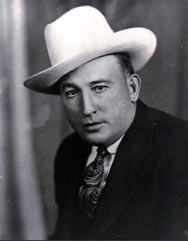
|
Henry Buckner - Sheriff
Adair County Sheriff’s Office June 12, 1954
Henry Buckner was born at Stilwell, Adair County, Oklahoma on September 29, 1913, to William F. and Julia E. Buckner. In 1935 Henry Buckner married Clemmie Marie Tucker.
The evening of Saturday, June 12, 1954, Sheriff Henry Buckner, 40, and his wife Clemmie were at home playing canasta with friends, Bill and Betty Barker and Robert and Jewell Scruggs when the sheriff received a call on a drunken disturbance at the Gonzalis’ residence in Stilwell.
Chester Lee Gonzalis, 21, had come home drunk and did not like what his sister Margaret was cooking for dinner and threw the food out. Margaret hit Chester with a frying pan and said she was calling the Sheriff. Chester Gonzalis left with an unloaded 12-gauge shotgun. He then borrowed some 12-gaug shells for the shotgun from a neighbor.
A short time later Sheriff Henry Buckner found Chester Gonzalis walking on Fogg Hollow Road. As Sheriff Buckner approached him, Gonzalis fired at Sheriff Buckner. One of the pellets struck Sheriff Henry Buckner in the heart killing him instantly.
The Buckners had seven children, Lawrence Mack, 18, Ruby Joyce, 15, Gaylee Ruth, 11, twins Shirley Ann and Sharon Kay, 8, Dowell Nathan, ?, Carol Deloris, ? .
Henry Buckner is buried in Stilwell Cemetery, Stilwell, Adair County, Oklahoma.
Henry Buckner’s wife Clemmie Marie Buckner lived to be over one hundred and two years old and is buried next to her first husband, Henry Buckner.
OLEM – 7N-4-1 NLEOM – 47W22
Updated September 14, 2023
|
|
|
|
|
|
Andrew Jackson Bullard - Sheriff
Roger Mills County, I.T. June 30, 1902
Sheriff Bullard and his Deputy John Cogburn were investigating reports of stolen cattle and horses on Monday, June 30, 1902. They located a group consisting of four men, a woman and two children about 6 p.m. near Dead Indian Creek eight miles north of the town of Cheyenne.
While Deputy John Cogburn talked with the rest of the group Sheriff Andrew Bullard talked to a man named Frank Doan about the group. While talking Sheriff Bullard observed a man, Pete Whitehead pass a gun to another man, Sam Green, the husband of the woman and father of the two children.
Sheriff Andrew Bullard started to ride toward the two men as Frank Doan rode away.
After a few minutes Frank Doan heard gunshots and saw Sheriff Andrew Bullard fall from his horse as Pete Whitehead and Sam Green rode away.
Returning to the camp, Frank Doan found Sheriff Andrew Bullard dead from eleven wounds from a shotgun blast. Deputy John Cogburn was also dead from being shot in the back. The suspects, believed to be members of the Bert Casey Gang, had taken the sheriff’s horse and rifle with them. The suspects were never arrested.
Andrew Bullard was survived by his wife Minnie and is buried in Cheyenne Cemetery, Cheyenne, Roger Mills County, Oklahoma.
OLEM – 5N-4-9 NLEOM – 1W24
Updated September 14, 2023
|
|
|
|
|
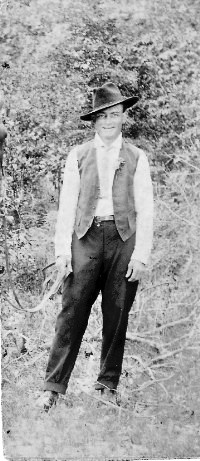
|
Charles L. Bullock, City Marshal
City of Delaware January 6, 1917
Charles L. Bullock was born March 19, 1885, in Red River County, Texas.
The morning of Saturday, January 6, 1917, a Delaware citizen named Thornbrew had been robbed and witnessed a grocery store being burglarized. Identifying the culprits as the Poe/Hart gang, a posse of seven men was quickly organized by City Marshal Charles Bullock and included two brothers, 31-year-old Delaware merchant, John Garritson and his brother Ed Garritson.
The posse trailed the suspects to a wooded gulch called Blue Canyon, northeast of Nowata. At the edge of the canyon the robbery suspects, members of the Poe-Hart Gang, ambushed the posse. City Marshal Charles Bullock and his posse John Garritson were shot to death and posse Ed Garritson was wounded but survived.
Charles Bullock was survived by his wife Sula Bess (Mabry) and their two children, Charles Edward, 4, and Sarah Allene, 2. Charles Bullock is buried in Mount Washington Cemetery, Lenapah, Nowata County, Oklahoma.
John Garritson was survived by his wife and is also buried in Mount Washington Cemetery, Lenapah, Nowata County, Oklahoma.
OLEM – 10S-3-6 NLEOM – 29E22
Updated September 14, 2023
|
|
|
|
|
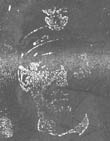
|
Robert L “Bob” Burden, Officer
Okmulgee Police Department May 16, 1921
On Monday, May 16, 1921, alert neighbors called the Okmulgee Police Station about two men who had just invaded the home of Mr. and Mrs. J. R. Harrison at 1504 East Sixth in Okmulgee. Officers Robert Burden, 56, and M. E. Spence quickly drove to the scene. Officer Spence parked the police car in front of the Harrison’s house and Officer Robert Burden got out of the car and started toward the house. Officer Robert Burden was immediately shot three times in the chest by the two robbers who were leaving the house with several thousand dollars’ worth of jewelry they had stolen. The two men then shot Officer M. E. Spence as he was still sitting behind the steering wheel of the police car trying to get his gun out.
Officer Robert Burden died on way to the hospital.
Officer Robert Burden was survived by his wife Eva and five adult children, Pearl, 34, William, 28, Florence, 24, Dolly, 19, and Doyce, 15.
Robert Burden is buried in Okmulgee Cemetery, Okmulgee, Okmulgee County, Oklahoma.
Officer M. E. Spence survived his gunshot wound.
OLEM – 3S-3-2 (Bob Burton) NLEOM – 2E23
Updated September 14, 2023
|
|
|
|
|
|
P. H. Burder – Wildlife Officer
Oklahoma Department of Wildlife
O. K. Bivins, with the Oklahoma Sheriffs and Peace Officers Association, was overseeing the construction of the new memorial and the names to be engraved on it.
This name was incorrectly added to the Oklahoma Peace Officers Memorial when it was built in 1969. According to the notes of O. K. Bivins this is a unique three-way transposition error between Bob Nolan, Bob Burton (true name Burden) and P. H. Nolan.
OLEM – 8S-3-20
February 25, 2022
|
|
|
|
|
.jpg)
|
Meagan Rose Burke – Sergeant
Oklahoma City Police Department September 29, 2022
Meagan Burke was born in California and raised in Colorado. Meagan made her way to Oklahoma when she joined the soccer team at the University of Central Oklahoma, where she was a goalie.
Meagan Burke joined the Oklahoma City Police Department in May 2016. After recruit school Meagan was assigned to the Springlake Patrol Division as a patrol officer. Later Meagan transferred to the highway interdiction unit and had recently transferred to the Santa Fe Patrol Division where she was a Field Training Officer.
At 12:34 a.m. the morning of Thursday, September 29, 2022, Sergeant Meagan Burke, 31, was driving north in the 3800 block of South I-44 on her way home from the Santa Fe Briefing Station where she had just completed a shift of Field Training Officer (FTO) overlap. At that same moment the driver of a south bound Blackhawk Security SUV lost control of his SUV, crossed over the center barrier and struck Sergeant Burke’s pickup truck head-on killing her. The driver of the Blackhawk Security vehicle sustained non-life-threatening injuries.
Sergeant Meagan R. Burke was the first female Oklahoma City Police Officer to die in the line of duty.
Meagan Burke was survived by her parents Pat and Pattie Burke and her older sister Kelley Burke.
The earthly remains of Sergeant Meagan Burke were cremated.
OLEM – 9N-3-21 NLEOM –
Updated September 14, 2023
|
|
|
|
|
|
Joseph Grant “Joe” Burnett – Officer
Oklahoma City Police Department
Joseph Burnett was born August 21, 1867, in Springfield, Missouri to Rolen C. and Elizabeth A. Burnett.
Joseph Burnett was given a commission as a Patrolman for the Oklahoma City Police Department in 1901.
Edward O. Kelly was on parole from Colorado for killing Bob Ford, the man who killed the famous outlaw Jesse James on April 3, 1882. Edward Kelly had murdered Bob Ford in Ford’s dance hall in Creede, Colorado, on June 8, 1892. Edward Kelly was acting under color of authority while the City Marshal of Creede. Kelly was convicted of second-degree murder and sentenced to life in prison. Edward Kelly spent ten years in prison before being paroled on October 3, 1902.
Edward Kelly arrived in Oklahoma City in December 1903 at the age of forty-six. Soon after arriving in Oklahoma City Edward Kelly was arrested by Officer Joseph Burnett. Newspaper accounts state that Edward Kelly was “mighty offended” and nursed a grudge against Officer Burnett.
Joseph Burnett’s primary claim to fame and the supposed source of the injuries that eventually claimed his life occurred on Wednesday, January 13, 1904. Edward Kelly was arrested by another officer that Wednesday and when released from jail later that day, he armed himself with two guns and bragged that he “was gunning for a policeman”. About 9 p.m. that evening Edward Kelly and Officer Joseph Burnett met each other in the 300 block of West First Street (now Park Avenue). As Edward Kelly drew his gun, Officer Burnett grabbed Kelly’s gun hand and hit him with his nightstick. For the next fifteen minutes the two men fought for seventy-five feet down the block and around the corner. Both men emptied their guns with Kelly cursing and biting while Officer Burnett called to bystanders for help. No one wanted to get involved until a baggageman from the nearby Frisco Depot, A. G. Paul, intervened. When Paul grabbed Kelly’s gun hand, Officer Burnett drew his second gun and shot Edward Kelly in the head killing him. Officer Burnett suffered flesh wounds to his left arm and hip, part of one ear bitten off and two bullet holes in his overcoat which was on fire from the muzzle blast of Kelly’s gun. Edward Kelly’s unclaimed body was buried two weeks later in an unmarked grave in Fairlawn Cemetery in Oklahoma City.
Joseph Burnett was promoted to Captain later that year. In 1909 he was promoted to Assistant Chief and served under Chief Bill Tilghman. When Tilghman left office in 1913, Burnett reverted to the rank of Patrolman.
Although Joseph Burnett remained on the police force, he allegedly never fully recovered from the injuries he had sustained in the fight with Edward Kelly. Joseph Burnett died on Friday, July 20, 1917, while being treated at Saint Anthony’s Hospital for “a stroke of paralysis” which was possibly a cerebral hemorrhage. Burnett was forty-nine years old when he died and was at the time the longest serving officer on the police department. Joseph Burnett was survived by his wife, Amanda, and three children, Nora, 19, Jerry, 13, and Kathrine, age 5. Joseph ’s brother, Roe Burnett, was also serving with the Oklahoma City Police Department when Joseph died.
Joseph Burnett is buried at Fairlawn Cemetery, Oklahoma City, Oklahoma County, Oklahoma.
OKLE – 8S-1-20
February 25, 2022
|
|
|
|
|
|
Cub Burney - Deputy Sheriff
Kiamichi County (Choctaw County), Choctaw Nation, I.T. July 10, 1901
On Friday, July 5, 1901, Deputy Sheriff Cub Burney, and a local citizen named J. H. McIntire had harsh words over an arrest at a Fourth of July barbecue at Goodland but were separated and each went home. Later that Friday night at about 9 p.m. J. H. McIntire went to Deputy Cub Burney’s home in Grant and called for him to come outside. Deputy Burney had already retired for the night but got up and went outside. The two men became involved in a fight and Deputy Burney was almost totally disemboweled by McIntire with a pocketknife.
Deputy Cub Burney died Wednesday, July 10th in a Paris, Texas hospital from his knife wounds.
The burial site of Deputy Sheriff Cub Burney is unknown.
J. H. McIntire was later arrested on Friday, August 16 in the Louisiana swamps, returned to Hugo, tried, and found guilty of manslaughter in the Federal Court at Antlers.
OLEM – 5N-4-15 NLEOM – 45E18
Updated September 14, 2023
|
|
|
|
|
|
John Luther Burns - Deputy Sheriff
McCurtain County Sheriff’s Office November 15, 1927
On Tuesday, November 15, 1927, Deputy Sheriff John Burns and four other McCurtain County deputies went to Glover, a small town ten miles northwest of Broken Bow, with a search warrant for an illegal still in the area.
The deputies located the illegal still about 1 p.m. Three of the deputies went to a nearby house belonging to Dave Henry, Jr. while Deputy Sheriffs John Burns and Joe Bolen began pouring out the barrels of illegal whiskey. Soon deputies Burns and Bolen were fired upon by a rifle from ambush. Deputy Sheriff John Burns, 51, was shot in the left side and soon died at the scene. Deputy Sheriff Joe Bolen, who was unarmed, escaped unharmed by jumping off a bluff into the Glover River.
Deputy Sheriff John Burns was survived by his wife Kitty and five children, daughter Eva Mae, 25, son John Raymond, 21, daughter Trula Marie, 17, son Odis Noel, 16, and daughter Mida Allene, 14.
John Burns is buried in the Denison Cemetery in Idabel, McCurtain County, Oklahoma.
OLEM – 2N-2-14 NLEOM – 34E22
Updated September 14, 2023
|
|
|
|
|
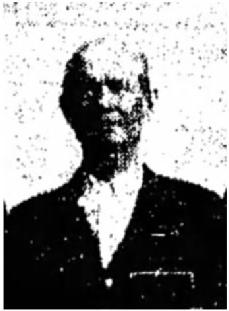
|
Benjamin B. “Ben” Burrough – Deputy Sheriff
Choctaw County Sheriff’s Office
Benjamin B. Burrough was born in Arkansas on April 7, 1870. He was raised in Blossom Depot, Texas before coming to Oklahoma in 1903.
Benjamin Burrough became a Choctaw County Sheriff in 1907 and served as a deputy sheriff for over thirty-two years. Benjamin Burrough also served as a Constable for Oakes Township and Roper for several years. Benjamin Burrough retired as a Choctaw County Deputy Sheriff in 1939.
Arthur Getts was a local farmer in Choctaw County who had served a sentence in the El Reno Federal Reformatory apparently after being arrested by Deputy Sheriff Benjamin Burrough and was still holding a grudge.
About 6 p.m. on Saturday evening February 27, 1943, Benjamin Burrough, 72, was in Soper talking with another man on the street when Arthur Getts, 42, walked up to them and said to Burrough: “You caused me a lot of trouble once when you carried a gun, but you haven’t got one now” and started insulting Burrough. Benjamin Burrow knocked Arthur Getts down and waited for him to get up. Arthur Getts got up and struck Benjamin Burrough knocking him down and kicked Burrough to death.
Arthur Getts was arrested and charged with murder.
Benjamin Burrough was a widower and was survived by his five adult children including two sons, O. A. and A. L. “Leon” Burrough, and three daughters, Ethal, Velma and Lorene.
Benjamin Burrough is buried next to his wife in Soper Cemetery, Soper, Choctaw County, Oklahoma.
Arthur Getts went to trial for murder in October 1943. After about three hours deliberation the jury found him innocent. Getts pleaded self-defense, declaring that Burrough was the aggressor in the fight.
OLEM – 7N-3-4
February 24, 2022
|
|
|
|
|
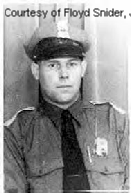
|
Walter C. Busch - Patrolman
Tulsa Police Department October 11, 1944
Walter C. Busch, Sr. was born July 9, 1906, at Hamburg, Erie County, New York to Charles Henry and Emma (Brunner) Busch. Walter C. Busch, Sr. worked for the Tulsa Pipe and Supply Company before joining the Tulsa Police Department in September 1938. Officer Busch was assigned to the police department’s traffic department in May 1940.
On Tuesday, October 10, 1944, Officer Walter Busch, 38, was chasing a speeding motorist on his police motorcycle when he was involved in a traffic accident at Seventeenth Street and Quanah Avenue with Kenneth O. Rawlings, 16. Patrolman Walter Busch’s injuries did not appear serious, but he died from his injuries about 10:30 a.m. the next day, Wednesday, October 11th at St. John’s Hospital.
Walter C. Busch, Sr. was survived by his wife Hazel and their three sons, Walter Charles, Jr., William and Charles Henry and a daughter Delora Faye.
Walter C. Busch, Sr. is buried in Rose Hill Memorial Park, Tulsa, Tulsa County, Oklahoma.
No charges were filed against Kenneth O. Rawlings.
OLEM – 7N-2-22 NLEOM – 54W7
Updated September 14, 2023
|
|
|
|
|
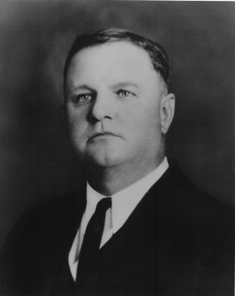
|
Grover Cleveland Butler - Chief Of Police
Tecumseh Police Department April 18, 1932
Grover Butler had served as Sheriff of Pottawatomie County from 1921 until 1925. He became Chief of Police of Tecumseh in 1928.
About 1:30 a. m. on Monday, April 18, 1932, Chief Grover Butler was making his rounds behind the Tecumseh Post Office. As he walked down the alley he was shot once in the back and once in the abdomen by Joe Smith who had been crouched under a porch at the rear of the building. Joe Smith had openly threatened Chief Grover Butler after he was arrested several times by the Chief. Chief Grover Butler emptied his revolver at the fleeing Joe Smith but missed him. Chief Grover Butler, 47, died eight hours later after he gave a dying statement identifying Joe Smith as his shooter.
Chief Grover Butler left behind his wife of twenty-six years, Louretta Ellen (Grimwood) and three sons, Arthur Glenn, 24, Grover Wilson, 20, and Franklin Grimwood “Grimmie”, 13.
Grover Butler is buried in Tecumseh Cemetery, Tecumseh, Pottawatomie County, Oklahoma.
Joe Smith was found guilty of the murder of Chief Butler and sentenced to life in prison.
OLEM – 8S-5-4 NLEOM – 54E21
Updated September 15, 2023
|
|
|
|
|
|
Otto P. Butler - Federal Prohibition Agent
U.S. Department of the Treasury December 11, 1929
On the evening of Tuesday, December 10, 1929, Agent Otto Butler, and his partner Agent George S. Danhour made an undercover purchase of liquor from John Young in his barber shop in Cushing then arrested him. When Agent Otto Butler went to search the rear of the barber shop, he was met by John Young’s wife, Latosca, who shot the federal agent several times. Latosca Young then ran to the front of the barber shop and shot Agent George Danhour. The shots attracted the attention of Payne County Deputy Sheriffs who responded and arrested both of the Youngs without resistance.
Agent George Danhour survived his wounds however Agent Otto Butler was dead on arrival at a Cushing hospital.
Agent Otto Butler was survived by his wife Mildred and three-year-old son Tommy and is buried in Fairview Cemetery, Cherryvale, Montgomery County, Kansas.
OLEM – 8S-4-8 NLEOM – 21W6
Updated September 15, 2030
|
|
|
|
|
|
William Henry Butler - Patrolman
Bartlesville Police Department January 5, 1915
William Henry Butler was born July 12, 1871, in Warren County, Kentucky to John Thomas and Margaret Laverna (Forgey) Butler.
William Butler married Sarah Mae Montgomery in 1893.
About 5 a.m. on Tuesday, January 5, 1915, Bartlesville Police received a call from a prostitute that the armed robbers they were looking for were in her place of business. Officers William Butler and Whipple were sent to the establishment to investigate.
The officers were directed to a second-floor room by the madam. The officers knocked on the room door then walked in and found the room occupied by two men, Arthur Martin and Will Putnam. Officer Whipple guarded Arthur Martin with his gun while Officer William Butler took Will Putnam into another room to search him. Finding no gun on Will Putnam, Officer William Butler walked back into the first room. As Officer Butler entered the room Arthur Martin drew a gun but Officer William Butler was able to draw his gun and shoot Arthur Martin. As Will Putnam came up behind Officer William Butler from the other room, he drew a gun that Officer Butler had failed to find during his search and shot Officer William Butler in the left side. Arthur Martin and Will Putnam then ran out of the building, but Arthur Martin fell dead a short distance away and Will Putnam escaped.
Officer William Butler was taken to the hospital but died at 8:30 p.m. that night.
William H. Butler was survived by his wife, Sarah, a son, and daughter and is buried in White Rose Cemetery, Bartlesville, Washington County, Oklahoma.
OLEM – 9N-1-11 NLEOM – 48W20
Updated September 15, 2023
|
|
|
|
|
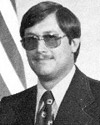
|
Donald L. Byerley - Sergeant
Tulsa Police Department December 15, 1980
Donald Byerley came to Tulsa from Mountain Grove, Missouri in 1964 and joined the Tulsa Police Department two years later. In 1978 Byerley was promoted to Sergeant and in October 1980 was night supervisor for the central and north patrol divisions.
Just after midnight the morning of Sunday, October 12, 1980, Sergeant Donald Byerley, 34, was transporting Tulsa Officer Curtis W. Haley to a garage to pick up his car as he had had car trouble and dropped it off at the garage earlier in the day. While in route to the garage Sergeant Byerly stopped a motorist, on the entrance ramp “acceleration lane” to west bound lanes of I-244 from Delaware Avenue. The officers had placed the driver, Earl McDaniel, 61, in the back seat of the police car which was parked on the shoulder with its emergency lights flashing. Officer Curtis Haley was in the back seat of the police car talking with Earl McDaniel, when a vehicle driven by Fred A. Clapp, 24, rammed the parked police car from behind. The two Tulsa officers and Earl McDaniel were pinned in the police car for almost an hour.
Sergeant Donald Byerley was transported to Hillcrest Hospital with a brain stem injury and never regained consciousness after the accident and died about 2 a.m. on Monday, December 15, 1980.
Earl McDaniel was also treated at Hillcrest Hospital and survived his injuries.
Officer Curtis Haley and Fred Clapp were treated at St. John Medical Center and survived their injuries.
Sergeant Donald Byerley left behind his wife, Diana and their two daughters, Angela, 12, and Kathy, 10.
Sergeant Donald Byerley is buried in Floral Haven Cemetery, Broken Arrow, Tulsa County, Oklahoma.
Fred A. Clapp was charged with driving while intoxicated, driving with no driver’s license, and transporting an open container of alcohol after the accident. He was also charged with First degree Manslaughter after Sergeant Byerley’s death.
OLEM – 2N-1-13 NLEOM – 41W5
Updated September 15, 2023
|
|
|
|
|
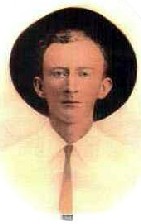
|
James Alexander "Coot" Byrd - Constable
City of Kingston August 29, 1927
James A. Byrd was born in what is today the state of Oklahoma on May 19, 1885.
About sundown on Friday, August 26, 1927, Constable James Byrd, 42, was standing on a sidewalk in Kingston having a heated discussion with C. P. Hoggard when “young” General Kizziar who was standing by the two men, pulled Constable Byrd’s gun from its scabbard, and hit the Constable on the right side of his head three times with the gun without saying a word, causing a fractured skull. Constable James Byrd was able to drive himself to the doctor’s office then home later. Constable Byrd lost consciousness during the night and was rushed to the Sherman Hospital in Sherman, Texas where he died Monday morning, August 29, 1927.
Constable James Byrd was survived by his second wife and three children and is buried in Kingston Cemetery, Kingston, Marshall County, Oklahoma.
General Kizziar along with C. P. Hoggard was charged with Constable James Byrd’s murder. C. P. Hoggard was the Kingston Justice and the father of James A. Byrd’s first wife, Rena, who had died in 1913. C. P. Hoggard had ordered General Kizziar to take Constable Byrd’s gun and hit him with it.
General Kizziar was found guilty of first-degree manslaughter and sentenced to fifteen years in prison.
OLEM – 4S-2-27 NLEOM – 53W23
Updated August 29, 2023
|
|
|
|
|
|
William Franklin Byrd - Patrolman
Oklahoma City Police Department August 2, 1919
William Byrd was an original member of the Oklahoma City Police Department’s Mounted Patrol formed on August 1, 1919. He was killed the second night of the unit’s existence.
The night of Saturday, August 2, 1919, Officer William Byrd, 35, was riding through the “negro district” in the east part of Oklahoma City when he heard shooting. He hurried to 509 N. Rhode Island where the shots had come from behind the house. Officer William Byrd dismounted his horse and asked a woman setting the porch where the shots had come from. She told him to go around back, and he would find out. Officer William Byrd had just walked around the corner of the house when a black man named Bill Roberts opened fire on him. Officer William Byrd was mortally wounded but was able to shoot Bill Roberts four times with his .45 caliber revolver before he died. Bill Roberts died the next day.
Officer William Byrd was not married and was survived by his mother and two half-brothers in Broken Bow where he is buried in the Broken Bow Cemetery, Broken Bow, McCurtain County, Oklahoma.
OLEM – 8S-3-19 (John Bird) NLEOM – 45W11 [W. F. Bird]
Updated September 15, 2023
|





